Physical Address
304 North Cardinal St.
Dorchester Center, MA 02124
Tumors involving the skull base of the anterior cranial fossa usually arise extracranially with secondary extension to the skull base. Occasionally intracranial tumors such as meningiomas may have extracranial extensions. The site distribution of tumors involving the anterior skull base is shown in Fig. 6.1 . The nasal cavity and ethmoid region are by far the most common sites of tumors, with secondary extension through the cribriform plate into the base of the anterior cranial fossa. The remaining group of tumors extending to the anterior cranial base are those arising in the lacrimal glands, frontal sinus, orbit, maxillary sinus, craniofacial skeleton, and soft tissues and skin of the forehead and scalp.
The most frequently encountered benign lesions involving the skull base are angiofibromas, osteomas, chondromas, and neurovascular tumors. The histologic distribution of malignant tumors invading the anterior skull base is shown in Fig. 6.2 . Squamous cell carcinomas, carcinomas of minor salivary gland origin, esthesioneuroblastomas, sinonasal undifferentiated carcinomas, neuroendocrine carcinomas, and melanomas are the most frequently encountered epithelial tumors. Somatic soft tissue tumors in this region include leiomyosarcomas, fibrosarcomas, angiosarcomas, and other rare tumors. Chondrosarcomas and osteogenic sarcomas are the most frequently encountered bone tumors. Most patients whose primary malignant tumors involve the central anterior skull base require craniofacial resection with preservation of the orbit. However, when direct extension to the orbit is present, then resection of the lateral anterior skull base along with orbital exenteration is indicated. This scenario is particularly true for malignant tumors arising in the orbit and lacrimal apparatus or those of the ethmoid sinuses with secondary extension to the orbit ( Fig. 6.3 ).
Neoplasms involving the middle cranial fossa are most commonly of neurovascular, soft tissue, or bone origin. The most frequently encountered neurogenic tumors are schwannomas and neurofibromas of the trigeminal nerve. Perineural extension of tumors along the trigeminal nerve is often seen from cutaneous and mucosal squamous cell carcinomas, melanomas, and minor salivary gland tumors such as adenoid cystic carcinomas. Soft tissue and bone sarcomas of the infratemporal fossa may involve the middle cranial fossa by direct extension. Benign and malignant paragangliomas also may extend to the middle cranial fossa through the foramina at the skull base.
Invasion of the temporal bone by primary tumors in the auditory canal or mastoid process requires special consideration. Although malignant tumors of the auditory canal are infrequent, invasion of the temporal bone by carcinomas of the parotid gland is not uncommon. The most frequently encountered neurogenic tumor of the temporal bone is the acoustic neuroma. The infratemporal portion of the facial nerve may be involved by perineural extension from neurotropic tumors of the skin or parotid gland. Neoplasms involving the posterior fossa at the skull base are those that extend through the jugular foramen, such as glomus tumors and chordomas of the clivus.
Open craniofacial resection remains the mainstay of therapy for a significant number of skull base neoplasms. Over the past two decades, there is increasing interest and enthusiasm for endonasal endoscopic resection of tumors involving the anterior central skull base. Although this approach has shown good early results, adherence to strict selection criteria is necessary to achieve similar cure rates as that from open operations. The earliest application of craniofacial surgery was reported by Dandy for a tumor of the orbit. A later report by Smith and Malecki described a craniofacial surgical approach for a tumor of the ethmoid. However, credit goes to Ketcham and colleagues for systematically developing a standardized technique of craniofacial resection for malignant neoplasms involving the nasal cavity and paranasal sinuses. Their early reports demonstrated nearly a doubling of survival time for patients with malignant tumors of the nasal cavity and paranasal sinuses compared with the previously used transfacial approaches alone. During the past 50 years, significant advances have taken place in technical refinements in craniofacial surgery, largely because of advances in imaging with the availability of computed tomography (CT) and magnetic resonance imaging (MRI) scans, development of better instrumentation, sophistication of surgical techniques with development of newer approaches, and availability of intraoperative neuronavigation. At the same time, availability of microvascular free tissue transfer allowed for more extensive resections, because it was now possible to repair major defects at the cranial base. Thus by the end of the 20th century, craniofacial surgery had become safe enough to become the standard of care for skull base lesions with significantly improved oncologic outcomes. However, morbidity and functional outcomes of surgery have remained a problem.
In the past 20 years, increased interest has been demonstrated in minimizing the morbidity of craniofacial surgery in selected patients through the use of endoscopic approaches. Endoscopic endonasal resection of benign lesions and favorable low-grade malignant tumors and small central malignant lesions at the anterior skull base is technically feasible, and safe in the hands of properly trained endoscopic surgeons. Published reports from experts from high-volume centers indicate that in properly selected patients, tumor control is similar to that achieved by open operations. However, the learning curve for achieving expertise in endonasal endoscopic resections for malignant tumors is quite steep, and significant expertise and experience in endonasal sinus surgery are essential before a head and neck surgeon, coupled with an equally expert endonasal neurosurgeon, can embark upon such surgical resections. Reported follow-up and outcomes data of patients undergoing such surgical interventions for malignant tumors from expert centers support its validity. Thus endonasal endoscopic skull base surgery in select patients now has an established role in skull base surgery.
Clinical evaluation and preoperative treatment planning for patients with neoplasms that involve the cranial base or are in proximity to the cranial base require special consideration. For most patients with malignant tumors that involve the anterior skull base, the primary lesions arise in the nasal cavity or paranasal sinuses, orbit, or the skin and soft tissues of the upper face and calvarium. Tumors of the infratemporal fossa and parotid gland and neurovascular tumors at the skull base often involve the floor of the middle cranial fossa. Tumors of the auditory canal may involve the temporal bone, and tumors of the seventh and eighth cranial nerves may involve the petrous apex and the cerebellopontine angle. Thus the workup and evaluation of these lesions are dependent on the site of origin and the histologic diagnosis before surgical intervention.
The routine clinical evaluation of such patients requires assessment of the function of the cranial nerves. Patients with tumors of the ethmoid complex may present with anosmia or an altered sense of smell. Tumors involving the orbit, the apex of the orbit, or the central skull base may present with disturbances of cranial nerves II, III, IV, and VI, manifested by partial or complete loss of vision or altered movements of extraocular muscles. Tumors at the base of the middle cranial fossa and in the infratemporal fossa may present with altered function of cranial nerve V, manifested by loss of sensation, or they may present with pain along the sensory branches of the fifth nerve and altered function of the muscles of mastication. Tumors involving the temporal bone may manifest with alteration of function of the facial nerve, presenting as facial weakness or paralysis, and those at the petrous apex may manifest with diminished hearing or loss of balance as the first sign of involvement of cranial nerve VIII. Symptoms resulting from involvement of the lower cranial nerves manifest as disturbances in swallowing, hoarseness of voice, altered clarity of speech, difficulty with mastication, or drooping of the shoulder. Tumors presenting at the jugular foramen classically involve cranial nerves IX, X, XI, and XII and may present with the classic combination of clinical signs and symptoms described as “jugular foramen syndrome.” However, cranial nerve dysfunction may not be readily apparent in patients with slow-growing neoplasms.
In addition to assessment of the cranial nerves, patients should undergo an audiogram, particularly for tumors of cranial nerves VII or VIII, tumors of the auditory canal, or when invasion of the temporal bone is suspected. Assessment of brainstem functions for tumors at the cerebellopontine angle and petrous apex is essential. A careful history regarding cerebrospinal fluid rhinorrhea or otorrhea should be taken, and appropriate testing should be done for confirmation of cerebrospinal fluid (CSF) leakage.
The mainstay of the preoperative workup for patients with tumors that approach or involve the skull base is radiographic imaging with CT and MRI. Direct preoperative angiographic studies and embolization are considered in highly vascular lesions and neurovascular tumors. Finally, balloon occlusion testing may be required in patients for whom circulation of one hemisphere is at risk because of the tumor or surgery.
Tissue diagnosis is essential in all patients except those with highly vascular tumors such as paragangliomas, glomus tumors, acoustic neuromas, and angiofibromas. However, these lesions have a characteristic radiologic appearance that is sufficient for a working diagnosis. A punch biopsy of lesions of the skin or those accessible through the nasal cavity and auditory canal should be performed. A CT-guided needle biopsy should be considered to establish tissue diagnosis of tumors that are not readily accessible.
Some skull base neoplasms such as paragangliomas or schwannomas have classic imaging characteristics that can point to a diagnosis (see Chapter 14 ). However, the primary reason to perform imaging studies in most patients with skull base tumors is to obtain anatomic information about the extent of the tumor. In certain circumstances, imaging is also necessary to determine the adequacy of circulation and to assess risk of cerebrovascular injury from surgical intervention. Finally, invasive angiography is indicated in select patients, including those who require embolization of their tumor or balloon occlusion testing.
Radiographic imaging of the extent of the tumor and its relationship to anatomic structures at the skull base is pivotal for making decisions regarding treatment and planning surgery. The most important features of a skull base tumor that influence treatment selection and surgical planning include the site and extent of bone involvement, relationship to the orbits, the extent of intracranial extension, and perineural spread. Both CT and MRI are excellent imaging modalities for delineating these characteristics, but they each have their specific attributes, which provide different information. Therefore most patients with skull base tumors will benefit from the information gleaned from both CT and MRI.
Bone erosion of the anterior skull base or orbit is generally evident earlier on CT compared with MRI. The coronal reformatted sequence of a sinonasal CT scan best demonstrates potential or actual tumor invasion of the skull base or orbit. Early erosion of the thin bones in this region, such as the cribriform plate/fovea ethmoidalis and lamina papyracea, is easily appreciated on the bone algorithm of the CT scan ( Fig. 6.4 ). MRI is likely to miss early bone involvement because of the thin nature of the bone and minimal fatty marrow medullary space in these bones, which makes evaluation difficult. An exception to this general rule is tumor involvement of the clivus, especially from nasopharyngeal carcinomas, in which case bone invasion is far more easily seen on an MRI scan than on a CT scan ( Fig. 6.5 ). Tumor invasion of the sphenoid and temporal bones can be detected either on CT or MRI scans, but MRI can be helpful in delineating the extent of involvement. CT scans can show cortical bone destruction easily, but the natural contrast of normal adult fatty “white” marrow against “dark” tumor seen on MRI scans is useful in providing an estimate of the extent of bone involvement. Ultrathin-slice CT imaging of the temporal bone in at least two planes is mandatory for evaluation of temporal bone tumors, and it easily shows bone destruction, including ossicular destruction that would be missed on an MRI scan.
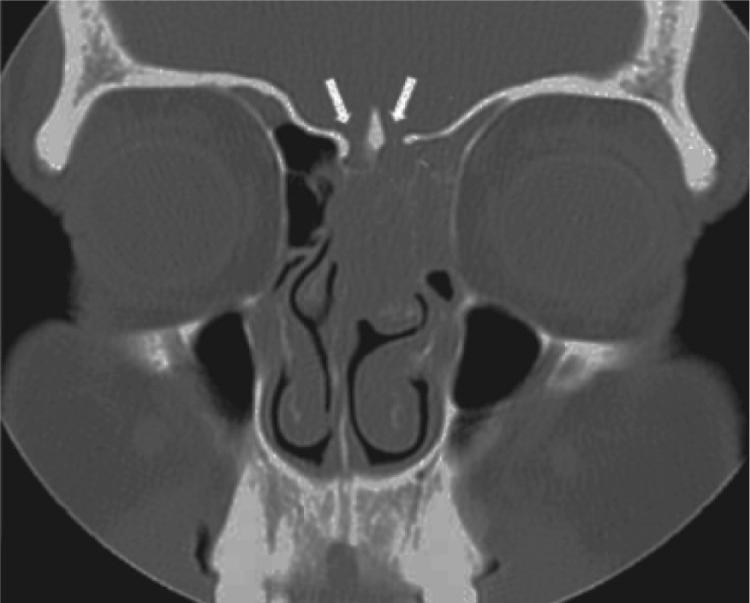
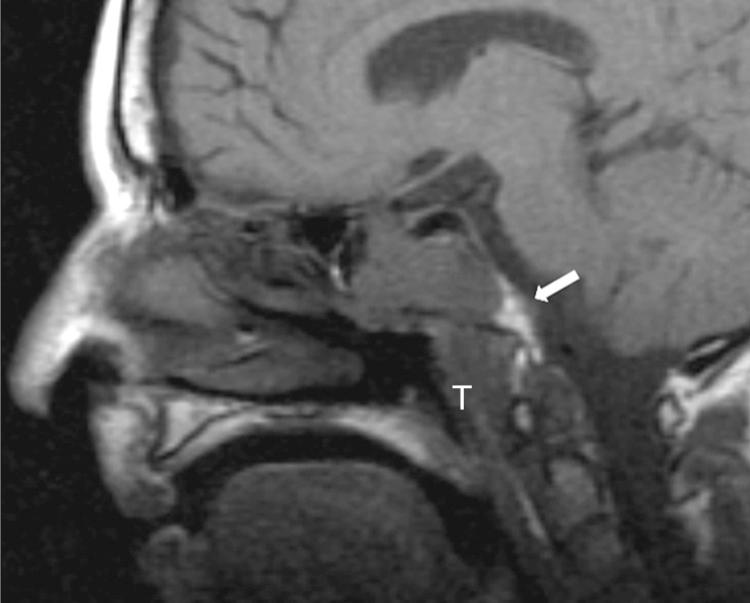
Involvement of the soft tissues, orbit, paranasal sinuses, and perineural spread is ideally evaluated by MRI. When evaluating for orbital soft tissue invasion, precontrast axial and coronal imaging is the best sequence to show the contrast of normal “white” fat infiltrated by “dark” tumor. Once contrast material is administered, utilization of the fat-suppression technique becomes necessary so that the enhancing “white” tumor does not blend into the normal orbital fat. The fat-suppression technique causes normal fat to become dark, which makes the enhanced tumor obvious ( Fig. 6.6 ). Precontrast axial T1-weighted images also are excellent for evaluation of extracranial perineural spread, such as in the pterygopalatine fossa (PPF) and along the infraorbital nerve. The “white”-appearing fat that is normally present in the PPF can be used as a natural contrast agent for the darker abnormal nerve affected by a tumor ( Fig. 6.7 ). Because fat in the PPF is easily imaged on a CT scan, perineural spread also can be diagnosed reliably if normal fat in the PPF is seen to be replaced by a tumor. Widening of the bony confines of the PPF provides additional evidence to support the diagnosis of perineural spread ( Fig. 6.8 ). To declare perineural spread of tumor, it is essential to demonstrate abnormal enlargement of the nerve as well as enhancement. If the nerve is in a bony canal, such as the infraorbital nerve, or if it is in a foramen, such as the rotundum or ovale, the canal or foramen is often widened, but the cortical margins remain intact on the CT scan ( Fig. 6.9 ).
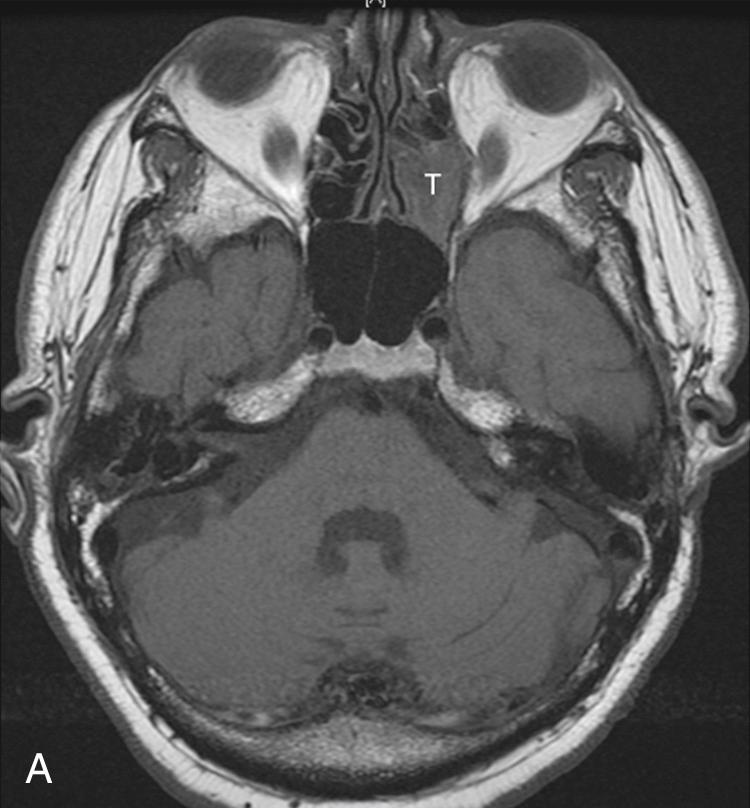
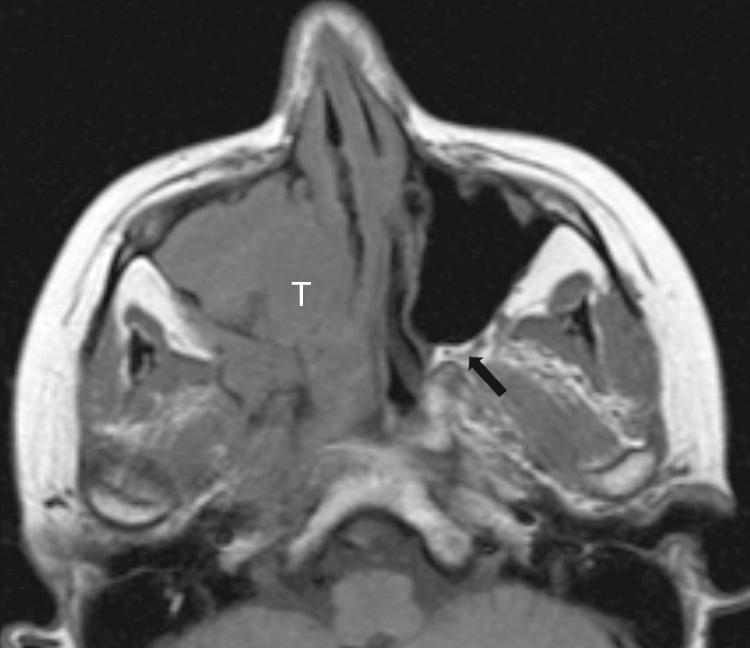
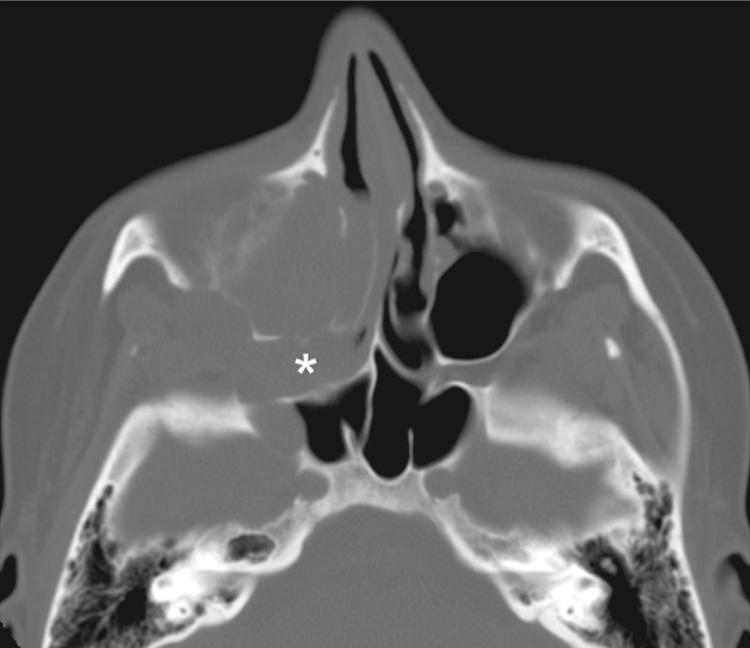

Extracranial perineural spread of a tumor along nerve V3 can be diagnosed easily by visualization of an enhanced, enlarged nerve on MRI ( Fig. 6.10 ). Intracranial perineural spread of a tumor into Meckel's cave and the cavernous sinus is best seen on a contrast-enhanced T1-weighted MRI scan. The T2-weighted sequence helps confirm invasion of Meckel's cave where the normally bright CSF is replaced by the dark tumor ( Fig. 6.11 ).
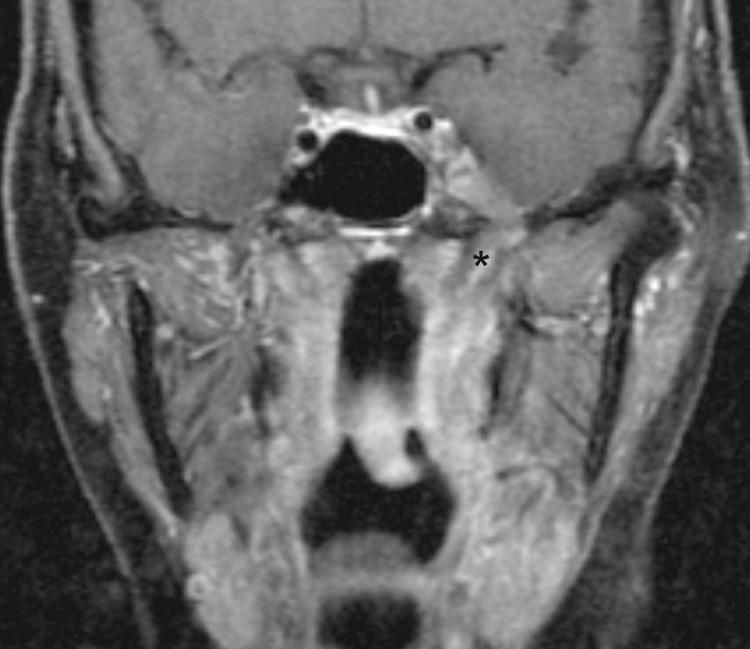
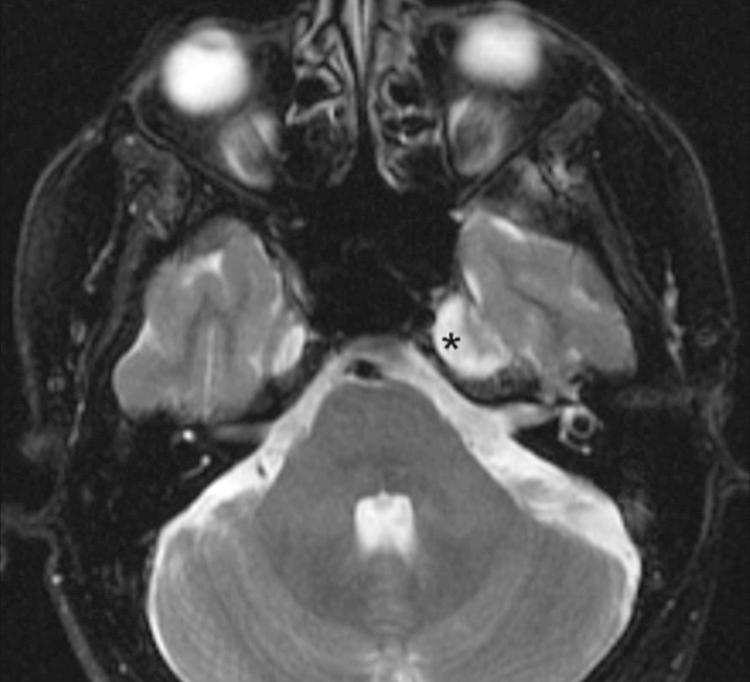
Intracranial extension of the tumor and involvement of the dura or brain are ideally demonstrated by MRI. Contrast-enhanced T1-weighted images in the sagittal or coronal plane are very accurate at detecting dural and/or parenchymal brain invasion, although minor dural involvement may not be easy to detect. Dural involvement is characterized by focal thickening and enhancement, and the scan also should be examined carefully for the extent of dural involvement ( Fig. 6.12 ). A peculiar feature of intracranial extension of esthesioneuroblastomas is the formation of peripheral cysts around the invading tumor ( Fig. 6.13 ). Although it is relatively uncommon with skull base tumors, leptomeningeal involvement by a tumor is an ominous prognostic sign ( Fig. 6.14 ). Once a tumor has invaded the brain parenchyma, the axial T2-weighted and short T1-inversion recovery sequences easily show associated edema, which is the hallmark of brain parenchymal invasion ( Fig. 6.15 ).
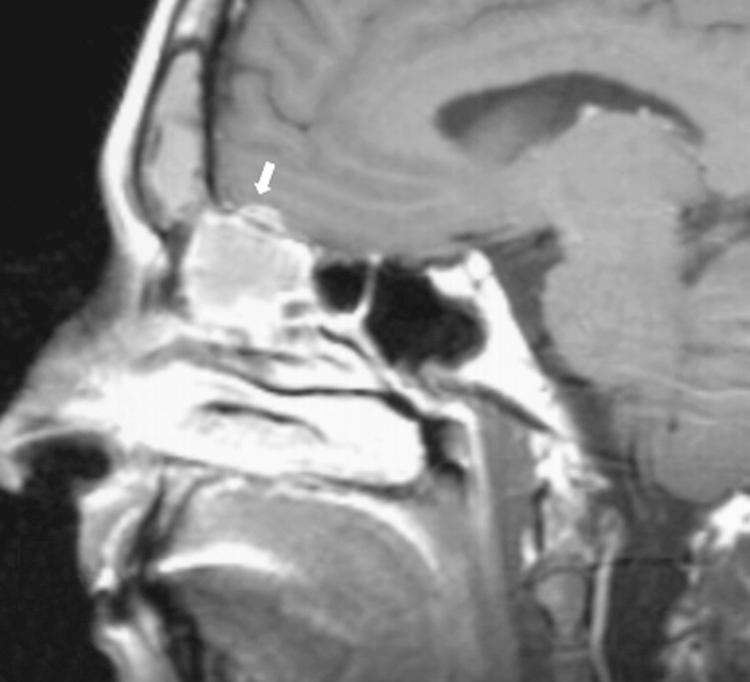
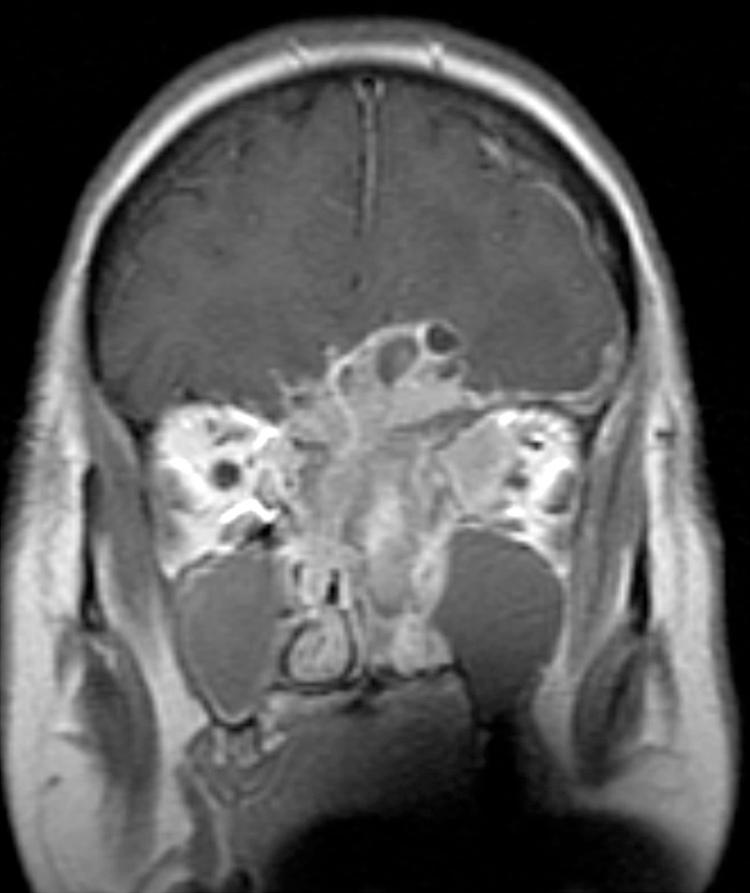
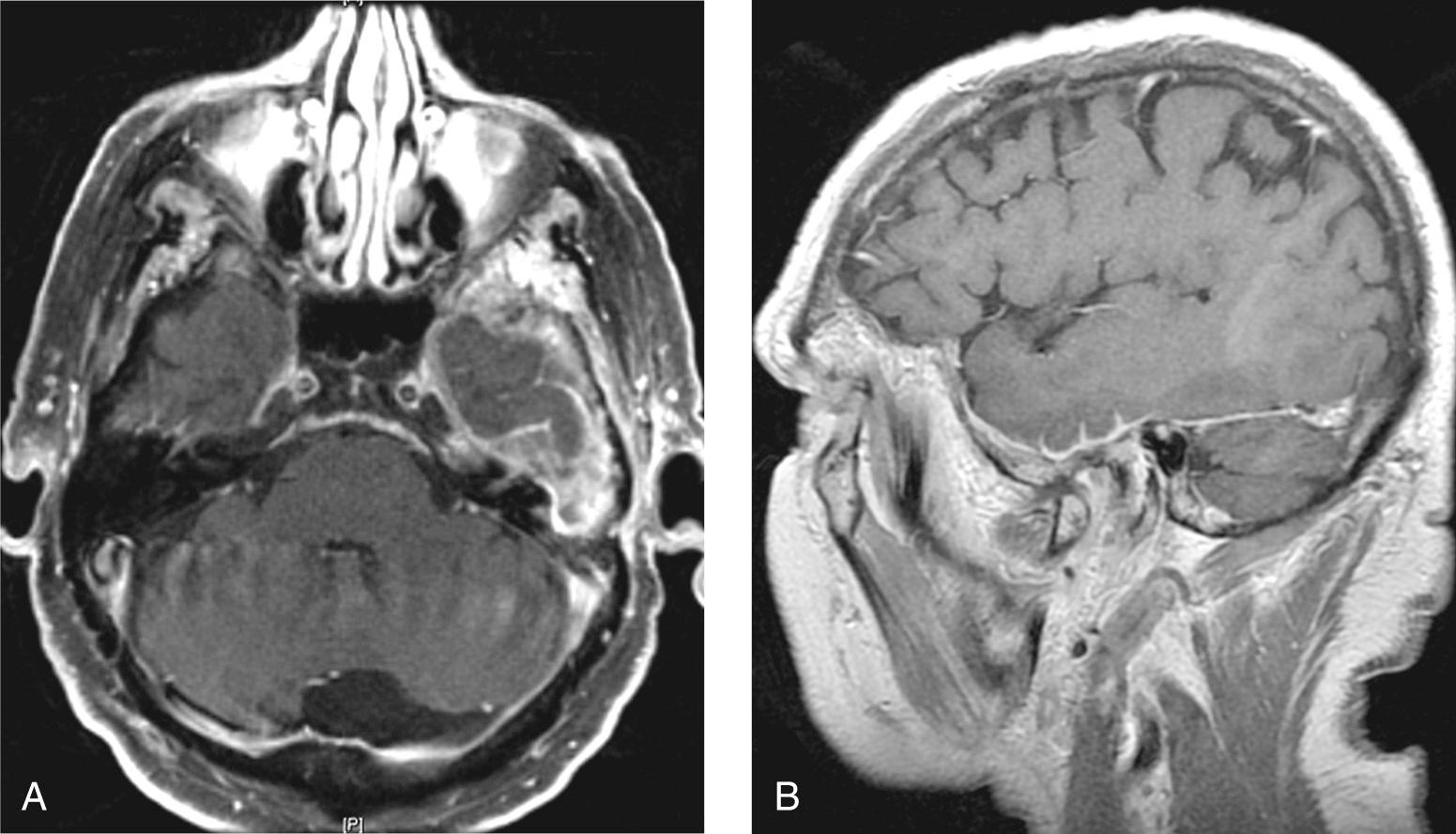
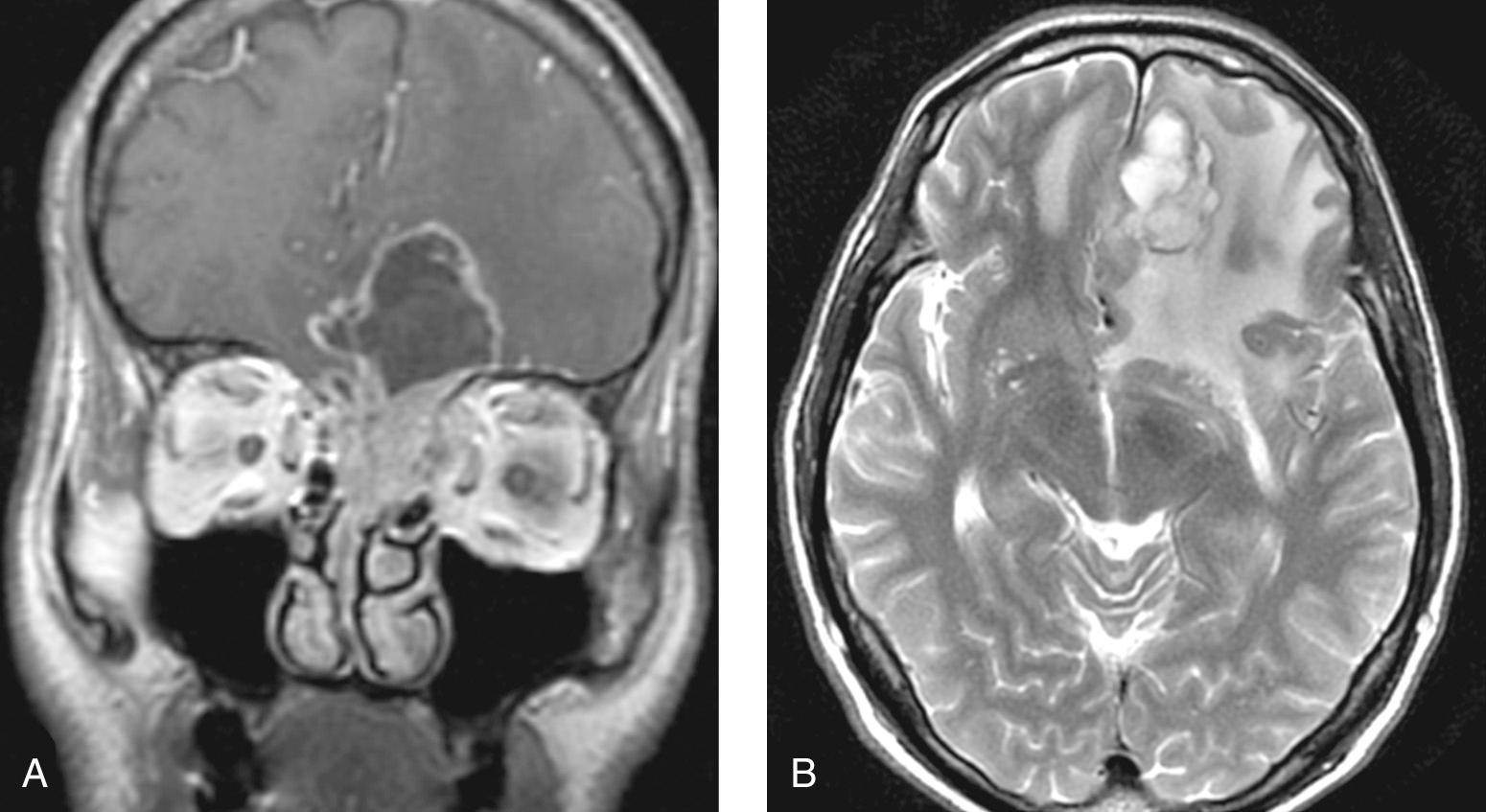
Fluorodeoxyglucose–positron emission tomography (FDG-PET) scanning has a limited role in the evaluation of skull base tumors but is a useful modality in posttreatment surveillance for differentiating treatment-related changes from recurrent disease.
Assessment of circulatory patency is indicated when surgical intervention involves resection of or risk of injury to a major artery, such as the internal carotid artery or a major sinus artery. Noninvasive imaging tests such as magnetic resonance angiography (MRA) and CT angiography (CTA) are adequate at demonstrating the anatomic relationship of the tumor to the major blood vessels. However, invasive angiography is required to assess the potential neurologic sequelae of occlusion of a major vessel, such as the carotid artery. Angiography also is indicated if preoperative embolization of the tumor is part of the treatment plan, for example, for juvenile nasopharyngeal angiofibromas or meningiomas.
Demonstration of the anatomic patency of the cerebral circulation and its collaterals, however, does not accurately predict the risk of cerebral ischemia if sacrifice of the internal carotid artery is required. Several methods have become available for more precise evaluation of adequate cross-circulation to the brain through the circle of Willis. These methods include transcranial Doppler examination, single-photon emission computed tomography (SPECT) with balloon occlusion of the carotid artery, and angiography and balloon occlusion and 99m Tc-hexamethyl-propyleneamine oxime brain SPECT. Balloon occlusion of the ipsilateral carotid artery and 99m Tc-hexamethyl-propyl-eneamine oxime brain SPECT has the best sensitivity and specificity, but even this test is not entirely reliable in predicting the risk of cerebral ischemia because it does not take into account the adverse impact of other potential intraoperative events such as hypotension and hypoxia. Additionally, a finite risk of stroke exists if the surgical procedure affects other collateral vessels not assessed by balloon occlusion testing or if thromboembolism develops after ligation of the carotid artery. Moreover, to perform these invasive angiographic procedures safely, a multidisciplinary infrastructure is essential, and the tests themselves carry a risk of neurologic complications.
Initial definitive treatment for most patients with neoplasms that involve the skull base entails surgical resection. In general, most patients with malignant tumors will require adjuvant postoperative radiation therapy because of the proximity of the surgical margins to the vital structure, which limits the ability of the surgeon to secure generous margins. Nonsurgical treatment with radiation and/or chemotherapy is reserved for patients with tumors that technically cannot be resected and for patients who otherwise are not surgical candidates. Some benign tumors such as schwannomas and paragangliomas may be managed expectantly with continued surveillance. Chemotherapy with or without radiation therapy may be used for lymphomas involving the skull base.
The complex anatomy of the vital structures at the base of the skull make surgical resection of tumors involving this area extremely difficult. Tumors of the nasal cavity, paranasal sinuses, orbit, scalp, and calvarium may extend to the anterior cranial fossa through the base of the skull. Further spread of these tumors can lead to intracranial extension with involvement of the dura or brain. A thorough understanding of the anatomy is therefore essential to master complex surgical techniques for operative procedures in this area.
A complete review of the anatomy of the skull base is beyond the scope of this book; however, to recapitulate the anatomic structures at the base of the skull, several views of the human skull are presented here.
A sagittal section of the skull through the left nasal cavity ( Fig. 6.16 ) shows the position of the floor of the anterior cranial fossa in relation to the sphenoid sinus, the nasal cavity, and the frontal sinus.
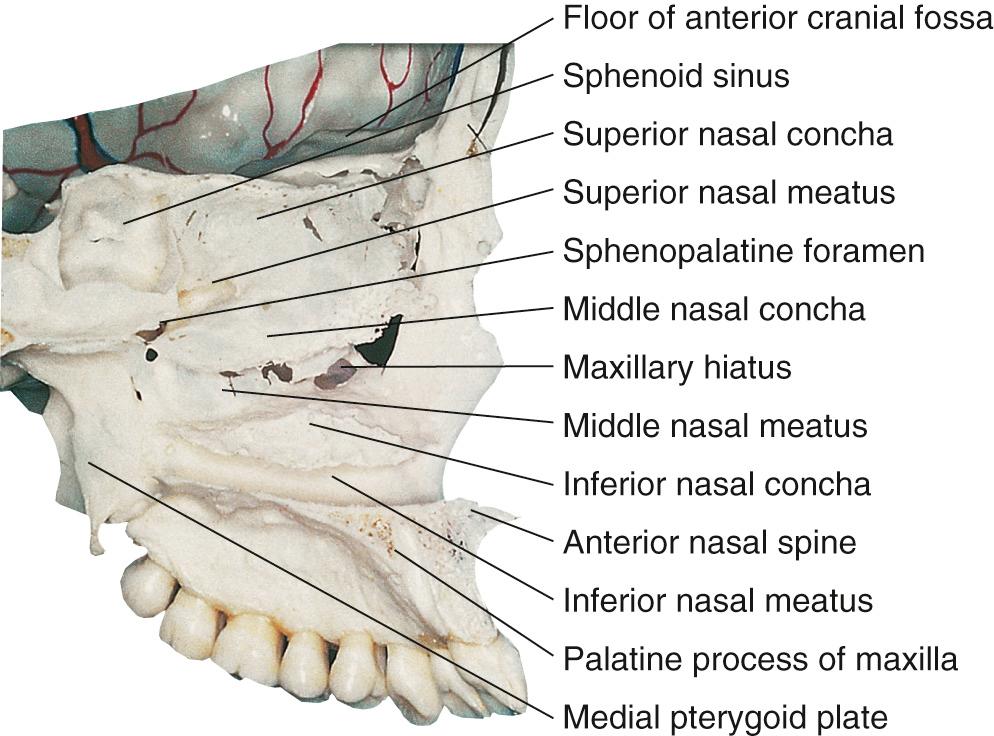
The intracranial view of the anterior cranial fossa ( Fig. 6.17 ) shows the anatomic structures located on its floor. The crista galli and cribriform plate, as well as the planum sphenoidale, are important landmarks to be remembered during surgery of the anterior cranial fossa.
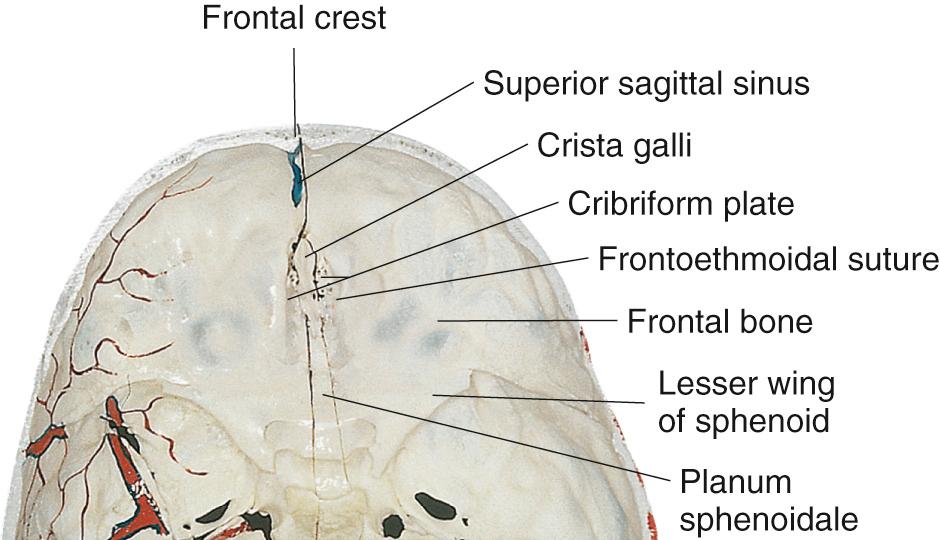
The intracranial view of the middle fossa ( Fig. 6.18 ) demonstrates the relative locations of the middle meningeal artery over the dura and the sigmoid sinus adjacent to the petrous portion of the temporal bone. These landmarks are vitally important in surgery of the middle cranial fossa and temporal bone. A skull should be available in the operating room to review the anatomy when surgical procedures are undertaken in these areas. A review of the anatomy of the petrous portion of the temporal bone in relation to the tumor to be surgically resected is vitally important before surgery. Radiographic studies including MRI and CT scans ( Figs. 6.19 through 6.21 ), as well as angiograms of the patient, should be reviewed with the skull in hand.
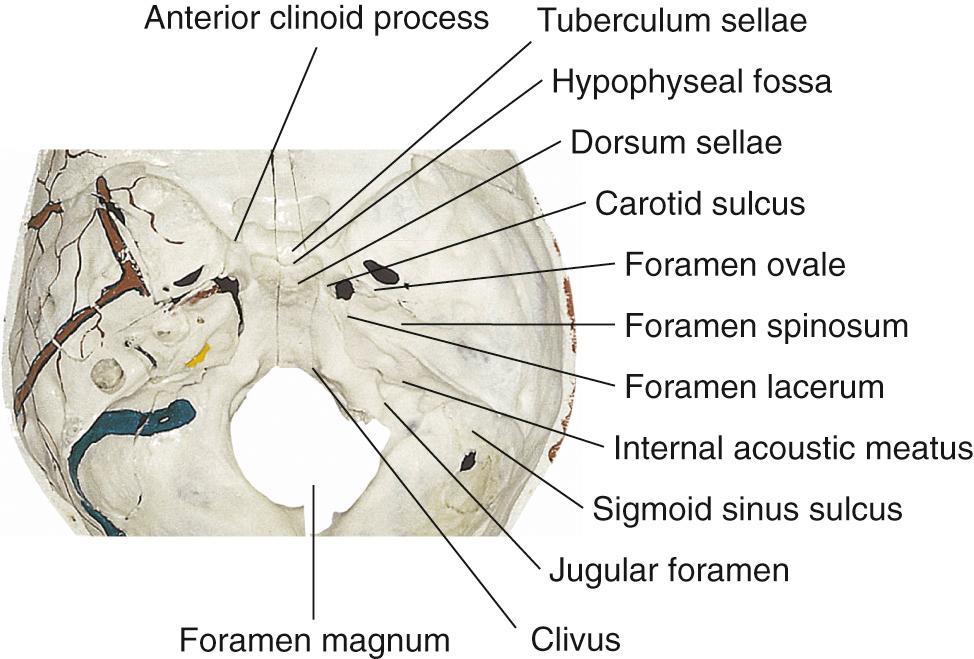
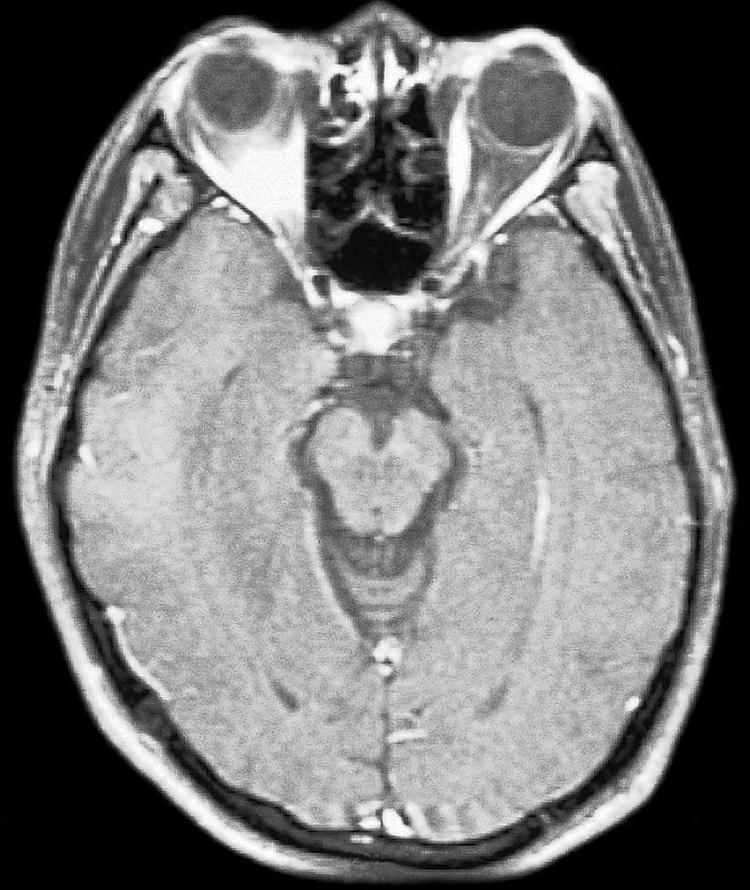
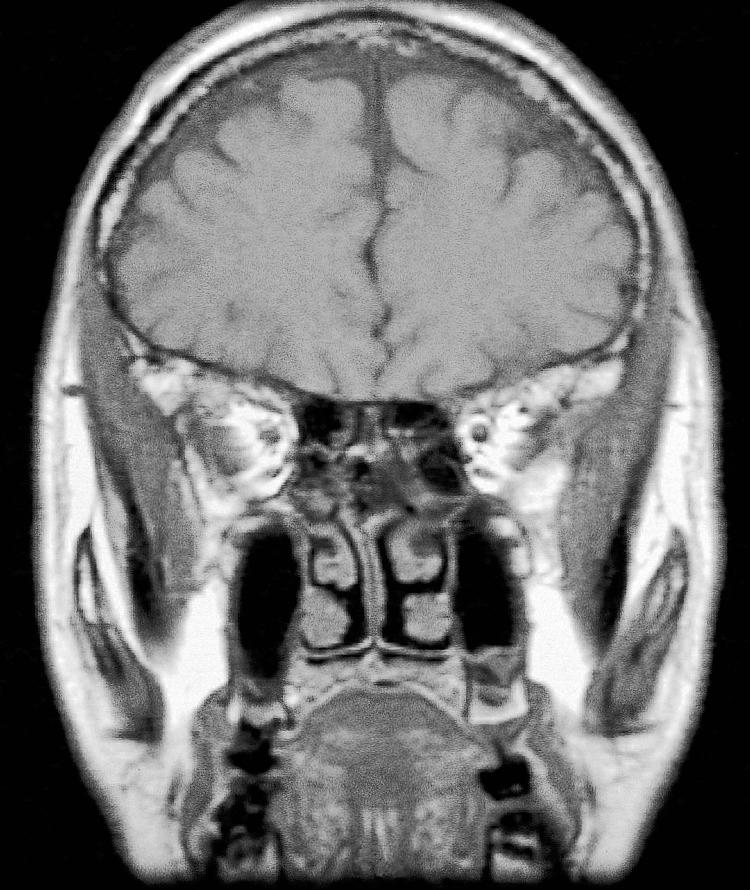
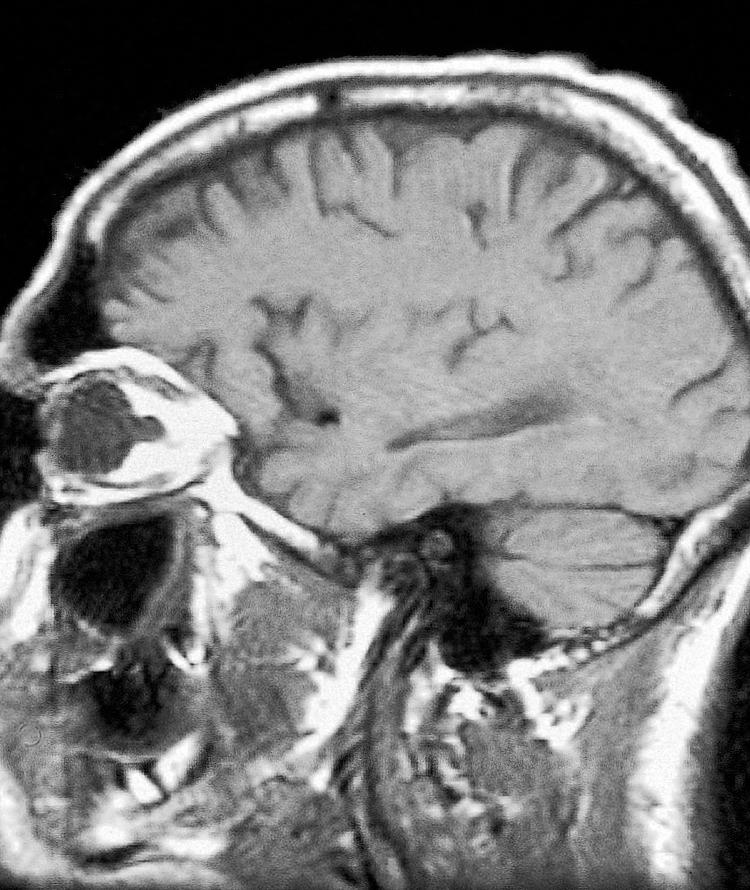
An oblique view of the extracranial aspect of the base of the skull at the middle fossa ( Fig. 6.22 ) demonstrates the area of the pterygomaxillary region and the infratemporal fossa. Tumors presenting in this region require special attention for exposure and resection, and the complex anatomy in these areas must be reviewed before undertaking surgical resection.
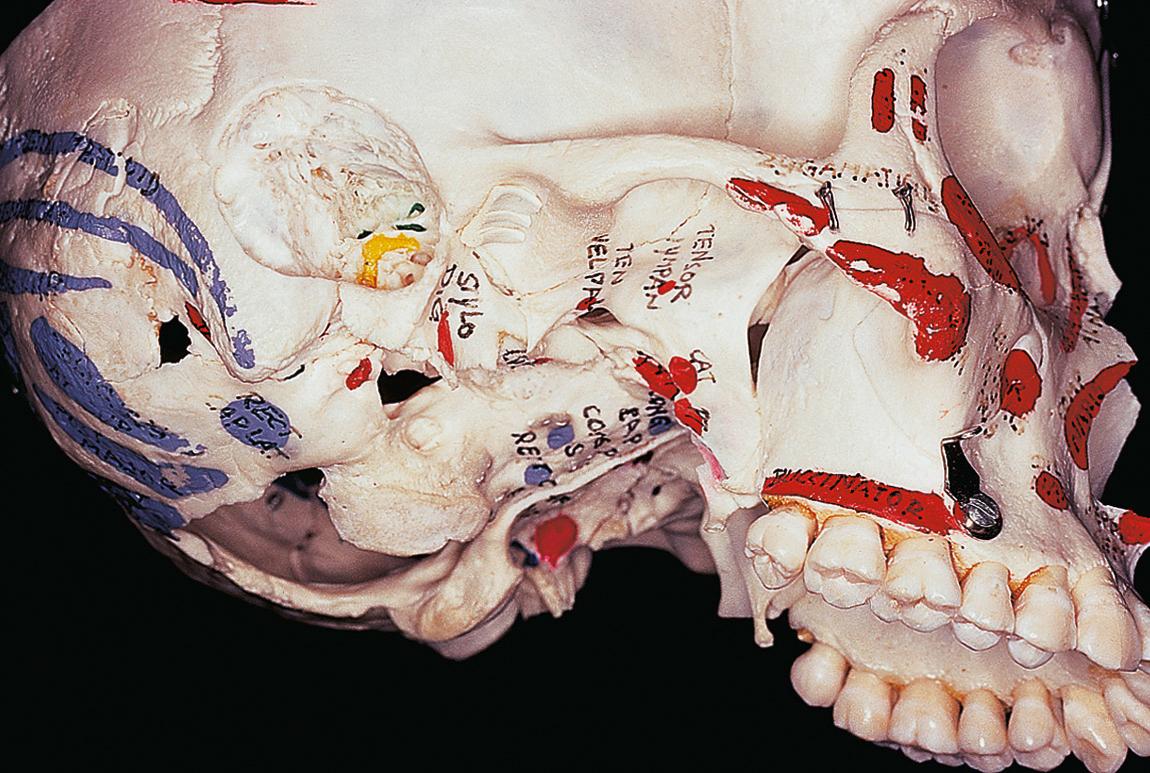
The fundamental problem in tumors involving the skull base is that access to these tumors is difficult. Use of the facial approach alone to address these tumors without adequate exposure and control of the intracranial component is likely to result in inadequate resection, CSF leakage, hemorrhage, and infection and its grave sequelae. One must adhere to the following principles when embarking upon craniofacial surgery:
Thorough review of imaging studies and tissue diagnosis is crucial to decide upon the surgical approach to be undertaken. Tumors with favorable histology and of limited extent without invasion of the orbit, frontal sinus, or intracranial extension may be considered for endonasal endoscopic resection.
If an open craniofacial resection is planned, then adequate exposure of the area of surgical resection must be obtained.
Brain retraction should be avoided whenever possible.
The brain can be slackened with use of either continuous spinal drainage or mannitol-induced diuresis. If the dura is injured or resected, a watertight dural repair must be undertaken, and the repaired area should be adequately covered with either a galeal-pericranial flap or a microvascular free flap.
A skin graft is sometimes used to provide an additional layer of support to the resected skull base. Use of a bone graft to repair skull base defects is seldom necessary. The clear-cut advantages of open craniofacial surgery are (1) a clear assessment of the resectability of the tumor can be achieved, (2) vital structures are protected, and (3) en bloc resection can be achieved. In addition, if the dura is involved it can be resected and repaired, and the surgical defect can be appropriately reconstructed to support the brain.
For the purpose of classifying operative procedures in various areas of the skull base, a scheme of division of different regions of the skull base is recommended. The skull base is divided into three regions anteroposteriorly; these are the anterior, middle, and posterior fossae, which are subdivided into several subsites. Midline structures in the floor, such as the crista galli, cribriform plate, and planum sphenoidale, constitute the anterior fossa cribriform plate region. Laterally, the floor of the anterior cranial fossa in the region of the roof of the orbit is called the anterior fossa orbit region ( Fig. 6.23 ). The squamous part of the temporal bone, the greater wing of the sphenoid bone, and the lower part of the parietal bone comprise the middle fossa skull base region ( Fig. 6.24 ). The auditory canal, mastoid process, and petrous portion of the temporal bone are described as the temporal bone region ( Fig. 6.25 ). Tumors that secondarily involve the petrous part of the temporal bone or present posterior to it and involve the clivus are classified in the posterior fossa/clivus region ( Fig. 6.26 ). Tumors that involve the cerebellopontine angle also can present in this location and involve the clivus.
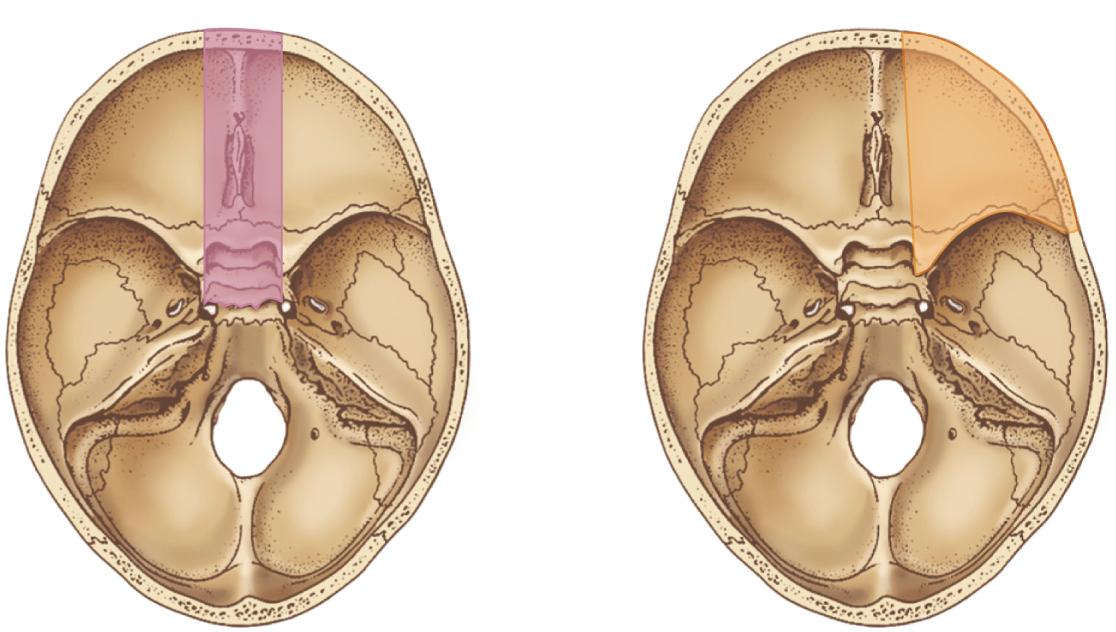
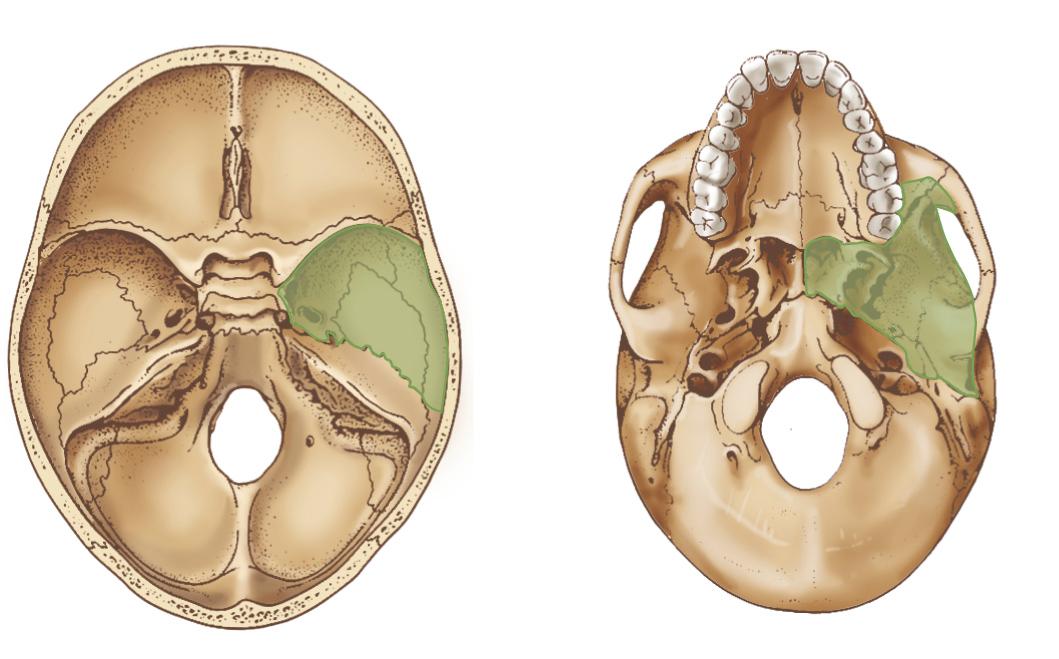
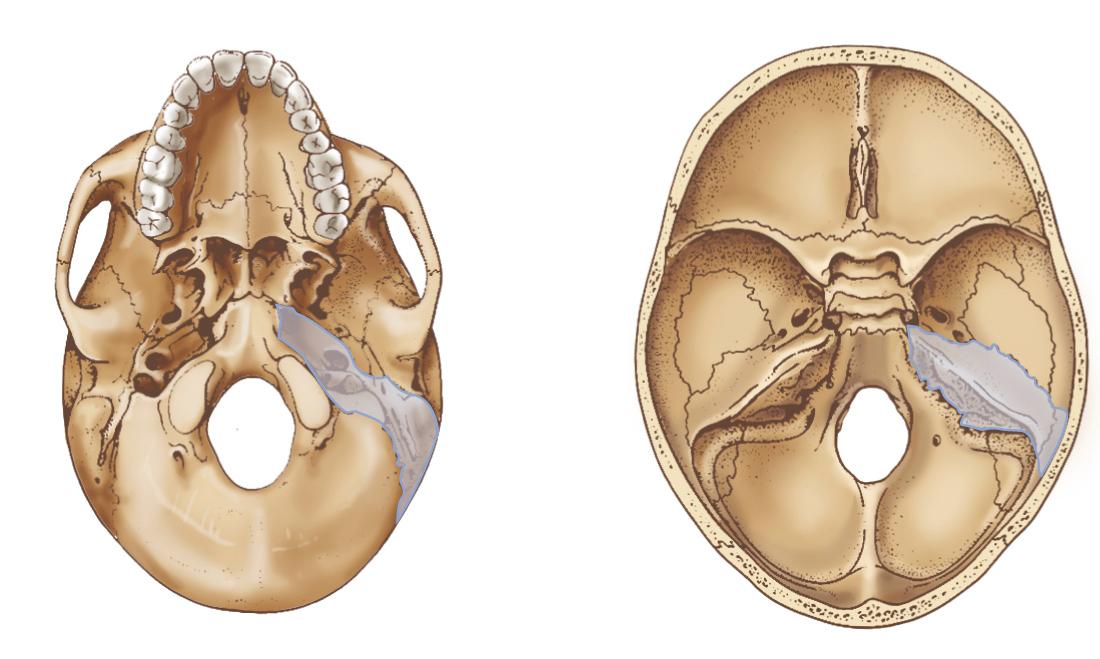
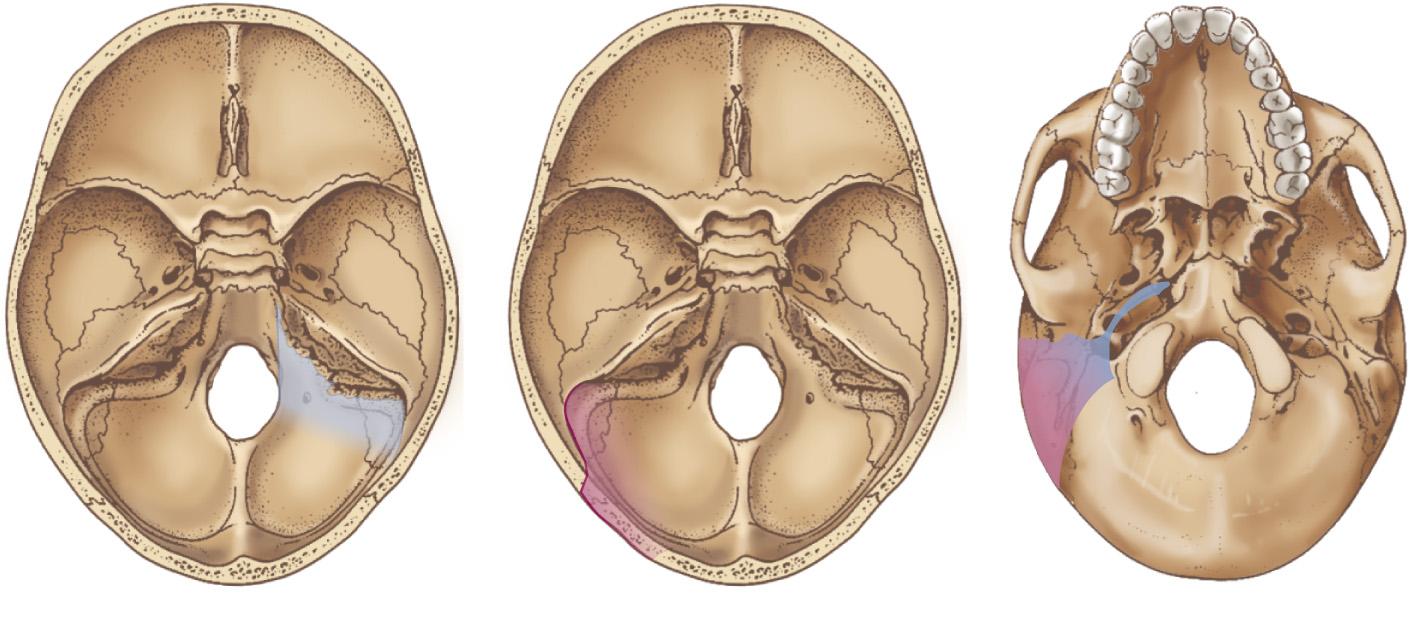
When patients present with a benign or malignant tumor with extension to the anterior skull base and the clinical and radiographic extent of the tumor makes a potentially curative operation technically feasible, craniofacial surgery should be undertaken. Craniofacial surgery is a team effort requiring the expertise of a multidisciplinary surgical team that consists of a head and neck surgeon, neurosurgeon, microvascular reconstructive surgeon, maxillofacial prosthodontist, diagnostic neuroradiologist, radiation oncologist, and a psychosocial-vocational rehabilitation team consisting of psychiatrists, occupational therapists, physiotherapists, and social workers. Furthermore, an expert operating room team and perioperative nursing support are essential for the successful outcome of craniofacial surgery. Successful skull base surgery is unlikely to be achieved in the absence of a well-established multidisciplinary team.
Increasing experience at multiple centers have revealed the limitations of skull base surgery for malignant disease. Thus the following contraindications for craniofacial approaches in the surgical treatment of patients with malignant disease have been defined:
Gross invasion of the brain
Invasion of both orbits
Encasement of the internal carotid artery (relative contraindication)
Invasion of the cavernous sinus (relative contraindication)
Advanced age of the patient (elderly patients are not suited physically, emotionally, and physiologically for such major surgical interventions)
Massive high-grade tumors (e.g., melanomas and poorly differentiated carcinomas and high-grade sarcomas) with dural invasion (relative contraindication)
Recurrent disease with invasion of the skull base following previous radiotherapy or chemoradiotherapy (relative contraindication)
All patients requiring craniofacial surgery should receive appropriate preoperative counseling regarding the nature and extent of the surgical procedure, the postoperative recovery and sequelae of treatment, and potential complications. Bacterial cultures from the nasal cavity should be obtained for patients undergoing resection of the floor of the anterior cranial fossa where direct communication will occur between the nasal cavity and the cranial cavity at the time of surgery. Preoperative antibiotics should be administered intravenously during the induction of anesthesia before an incision is made to provide broad-spectrum coverage. The antibiotic regimen should provide prophylaxis against gram-positive and gram-negative bacteria, as well as bacteroides. Our current preference is a combination of ceftazidime, vancomycin, and metronidazole. Intravenous antibiotic coverage is continued throughout the postoperative period as long as the nasal packing is in place (6–8 days).
For the purpose of describing various surgical approaches, the skull base is divided into four anatomic regions:
The floor of the anterior cranial fossa covering the roof of the orbit, the cribriform plate, and the planum sphenoidale is called the anterior skull base. This region also covers the posterior wall of the frontal sinus, the frontal crest, the crista galli, and the anterior clinoid processes up to the ridge of the lesser wing of the sphenoid. Thus the floor of the anterior cranial fossa is composed of the frontal bone, the ethmoid bone, and two parts of the sphenoid bone (the body and lesser wing) posteriorly.
The skull base of the middle cranial fossa consists of parts of the sphenoid and temporal bones. The fissures and foramen traveling through the middle cranial fossa are important from a surgical standpoint because several pathologic conditions involve these structures. The superior orbital fissure, foramen rotundum, foramen ovale, and foramen lacerum pass through the floor of the middle cranial fossa. The posterior limit of the skull base of the middle cranial fossa is the superior ridge of the petrous temporal bone.
The temporal bone, particularly its petrous part, requires a separate anatomic designation because surgical approaches and the pathologic entities arising in the temporal bone are distinct.
Finally, the skull base of the posterior cranial fossa begins posterior to the temporal bone and is composed largely of the occipital bone, the jugular fossa and foramen, the hypoglossal canal, and the foramen magnum, which are all important structures from a surgical standpoint. Special consideration is also required for the undersurface of the middle cranial fossa, known as the infratemporal fossa, where significant pathologic entities arise that require specific surgical management considerations.
The most common pathologic conditions that require surgical intervention by the head and neck surgeon involve the skull base at the anterior and middle cranial fossae as well as the temporal bone. Lesions that arise from or involve the anterior cranial fossa generally are approached via a bifrontal craniotomy to get a wide exposure of the floor of the anterior cranial fossa and via a facial approach through a modified Weber-Ferguson incision. This approach also is suitable for tumors that involve or arise from the orbit and require orbital exenteration and resection of the roof of the orbit. However, this approach is not suitable for lesions that involve or arise from the floor of the middle cranial fossa. Some lesions of the central part of the floor of the anterior cranial fossa near the cribriform plate can be accessed through a subfrontal craniotomy. Selected central lesions of the anterior skull base can be accessed easily through an endonasal approach without the need for a facial incision.
The cranioorbito-zygomatic (COZ) approach is best suited for access to the floor of the middle cranial fossa and the infratemporal fossa. Disassembly of the zygomatic arch may be required to gain access to the deep temporal space. Other lesions at the floor of the middle cranial fossa, such as neurogenic tumors arising from the fifth cranial nerve or soft tissue tumors involving the floor of the middle cranial fossa, require surgical exposure via a pterional craniotomy to gain intracranial exposure. Transfacial access to these tumors can be obtained through a maxillary swing via a modified Weber-Ferguson incision or a mandibulotomy through a lower lip–splitting incision. Tumors arising in the lateral aspect of the infratemporal fossa are best accessed via a mandibulotomy, whereas tumors arising in the retromaxillary region, in the medial aspect of the infratemporal fossa, and in the nasopharynx are best approached via a maxillary swing procedure.
Tumors of the auditory canal and temporal bone require a temporal craniotomy for lateral subtotal or total temporal bone resection. Finally, a temporal or occipitotemporal craniotomy is required for adequate exposure and access to tumors arising in the posterior fossa (the far lateral approach described by Fisch). This access is required for neurovascular tumors, chordomas arising in the clivus or the craniocervical junction, and meningiomas arising at the cerebellopontine angle.
A variety of technical approaches are available for craniofacial resection for tumors involving the anterior skull base. The individual technique used varies with each surgeon and his or her personal preference. However, the standard surgical approach for resection of the anterior central skull base for a malignant tumor of the ethmoid is described here, followed by several technical variations.
The patient undergoing this procedure has an esthesioneuroblastoma that is arising from the region of the cribriform plate and is filling up the left nasal cavity. This patient presented with symptoms of nasal obstruction and epistaxis. A CT scan in a coronal view shows a bone-destructive lesion arising from the ethmoid region with extension caudad to involve the lower part of the nasal cavity and pushing the lamina papyracea of the left orbit laterally. A further posterior cut of the coronal view shows tumor extension in the sphenoid sinus through its floor. The tumor obstructs the osteomeatal complex of the maxillary antrum but does not extend into the maxillary sinus. Similarly, the tumor approximates the perpendicular plate of the ethmoid bone and the nasal septum but does not perforate through to extend to the opposite side of the nasal cavity. Although there is no intracranial extension of the tumor, it approximates the cribriform plate at the floor of the anterior cranial fossa ( Fig. 6.27 ). An endoscopic view of the tumor is shown in Fig. 6.28 .
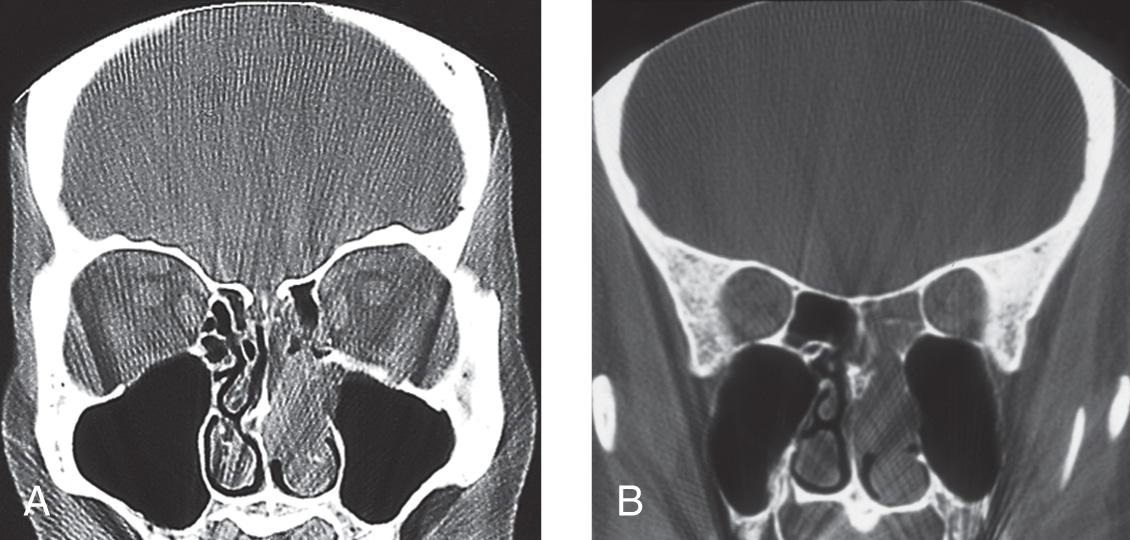
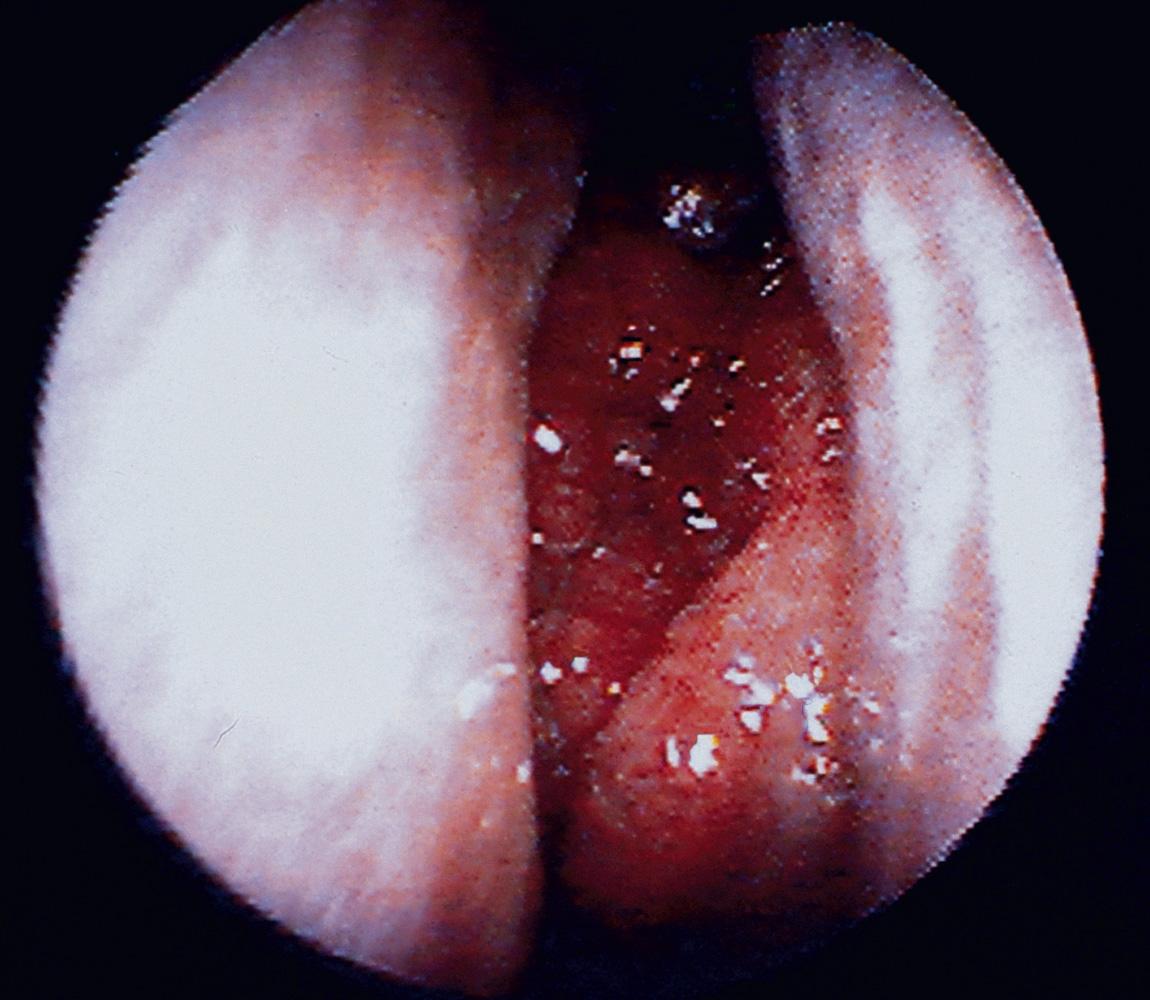
An artist's rendering of the extent of the tumor as seen on the coronal section of the CT scan is shown in Fig. 6.29 . Note that the surgical resection will include the cribriform plate and thus the central part of the anterior cranial base.
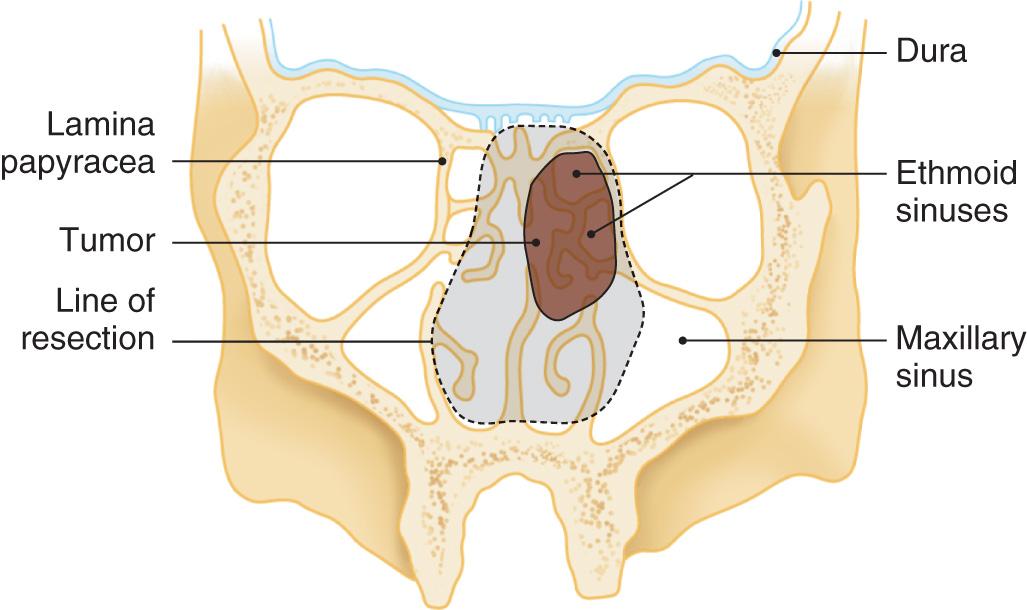
The extent of the tumor and the proposed surgical resection are shown in a sagittal plane in Fig. 6.30 . The anterior wall and the floor of the sphenoid sinus will be removed in conjunction with the tumor and the contents of the nasal cavity on the left-hand side.
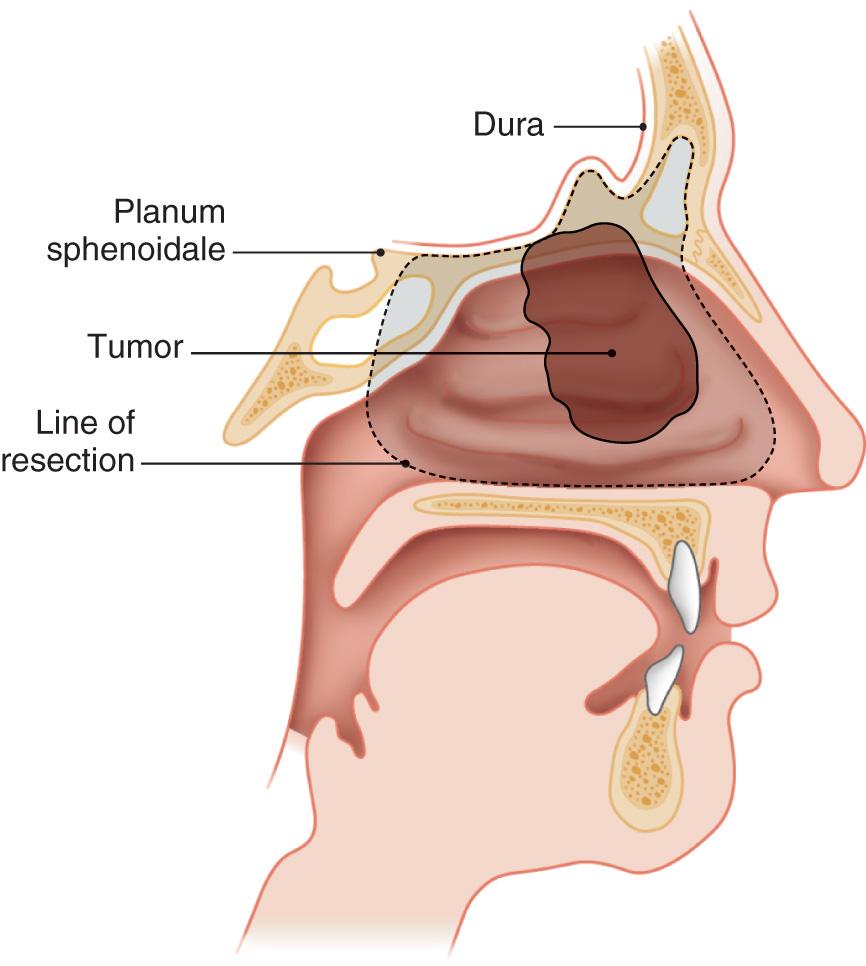
If a split-thickness skin graft is to be used for repair, it is harvested before beginning the surgical procedure for resection of the tumor. The anterolateral aspect of the thigh is the most suitable donor site. However, because the surgical defect in this patient will be small, it does not require a skin graft. On the other hand, if a free flap is to be used, then the appropriate donor site is isolated for simultaneous harvest of the flap.
The patient is then placed in the lateral position and a lumbar puncture is performed ( Fig. 6.31 ). An indwelling spinal catheter is introduced through the lumbar puncture needle for continuous spinal drainage and monitoring of the CSF pressure during the procedure and in the immediate postoperative period. The spinal catheter is appropriately positioned and connected to a closed circuit drainage system with a 50-mL syringe. The patient's head is appropriately positioned on the operating table on a head rest and maintained in a neutral position with slight flexion at the atlanto-occipital joint ( Fig. 6.32 ).
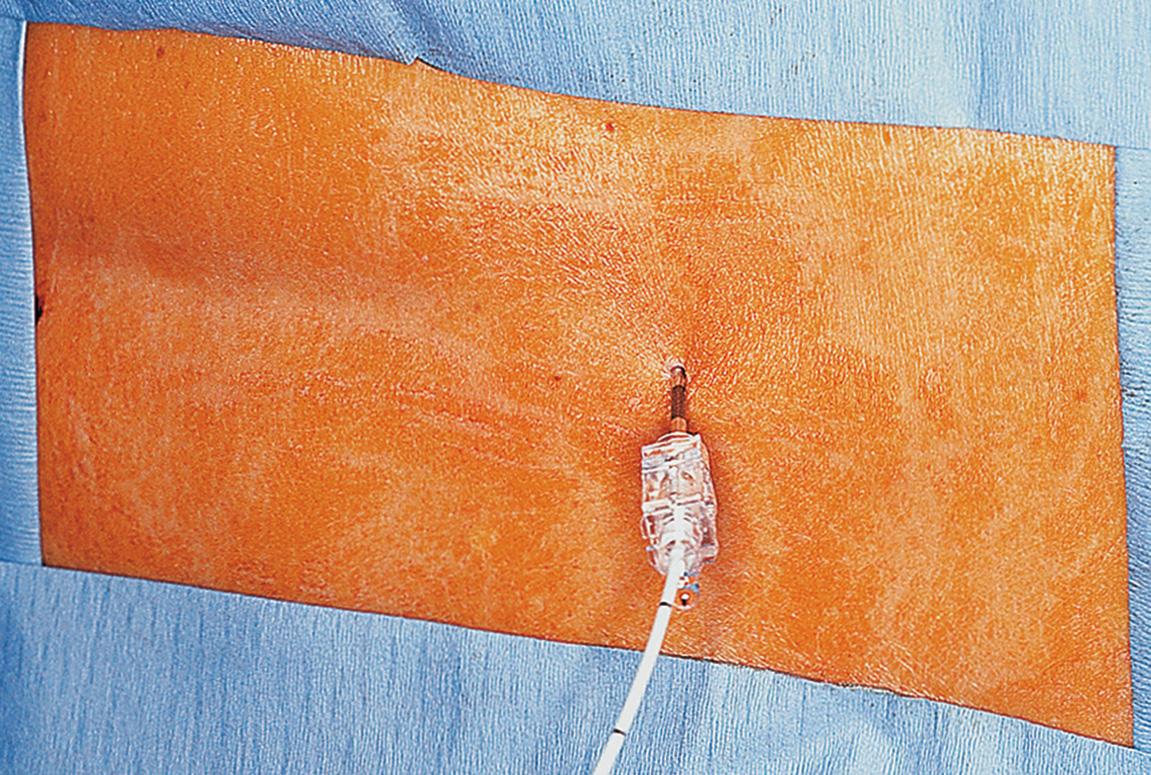
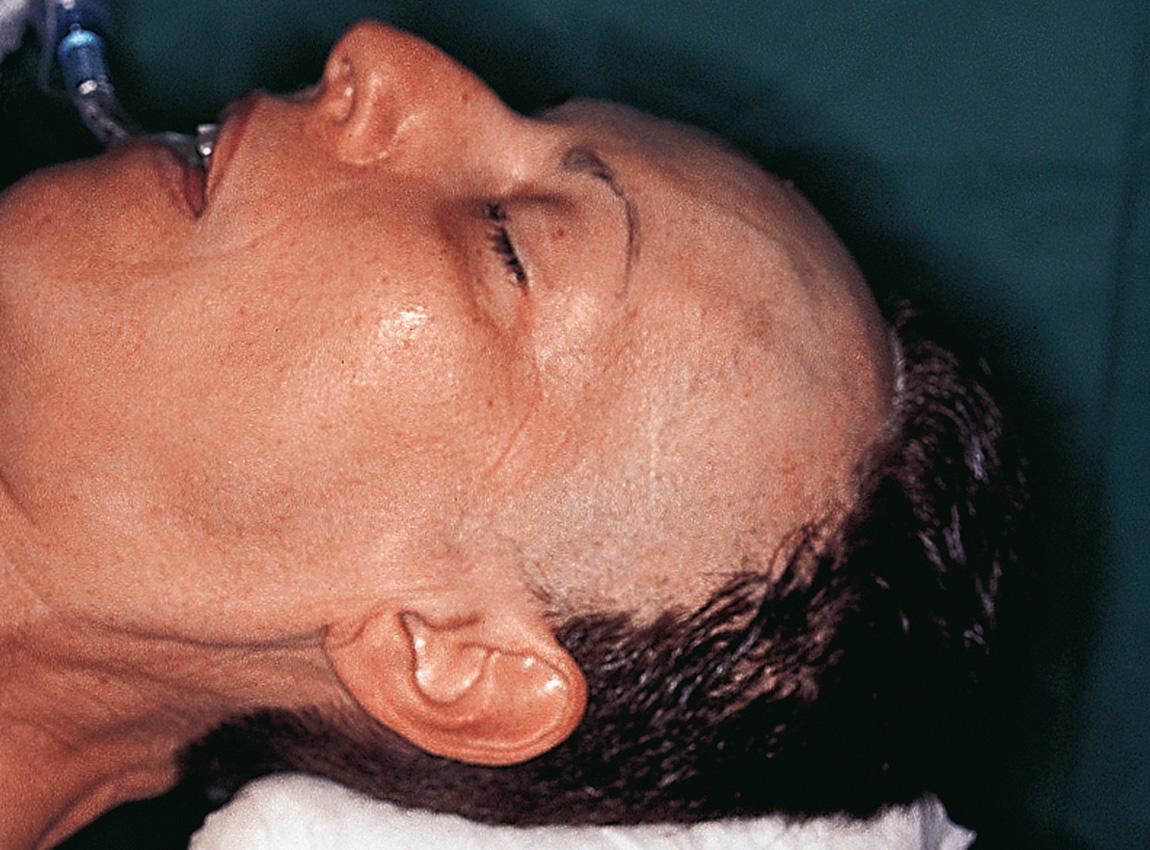
General anesthetic is administered through an endotracheal tube that is brought out through the commissure of the oral cavity on the right-hand side and isolated by sterile drapes. The eyelids are sutured shut with 6-0 nylon sutures through the skin of the upper and lower eyelids to protect the cornea during the surgical procedure. The scalp is shaved in the area of the craniotomy incision. Cloth drape towels are sutured to the skin with silk sutures to maintain strict asepsis and isolation of the field. The skin of the face and scalp is prepared with Betadine solution. The proposed lines of incisions are shown in Fig. 6.33 . A bicoronal incision is planned posterior to the hairline extending from the tragus of one ear to that of the other to provide a wide exposure for the anterior fossa craniotomy ( Fig. 6.34 ). The facial exposure is usually obtained through a modified Weber-Ferguson incision, respecting the nasal subunits ( Fig. 6.35 ). If exposure of the lower half of the nasal cavity, hard palate, or maxilla is required, then the incision is extended to split the upper lip in the midline. The incision then follows the nasal subunits along the nasolabial fold and extends up to the medial end of the eyebrow. Two potential extensions of the incision can be used, depending on the required exposure. A glabellar extension up to the opposite eyebrow can be used if facial disassembly of the nasal bones is planned to gain the necessary exposure. On the other hand, if a total maxillectomy or a maxillectomy with orbital exenteration is required, then a subciliary extension up to the lateral canthus is used, as shown with the dotted line in Fig. 6.35 . The scalp is incised through its subcutaneous tissue up to a plane superficial to the galea aponeurotica and the pericranium ( Fig. 6.36 ). The plane between the subcutaneous tissue and galea is tedious to dissect, under the posterior scalp flap. The posterior scalp flap is elevated several centimeters posteriorly to expose the pericranium. Hemostasis on the cut edges of the scalp can be secured with use of Raney clips. These hemostatic clips are applied on both edges of the cut incision as shown in Fig. 6.37 .
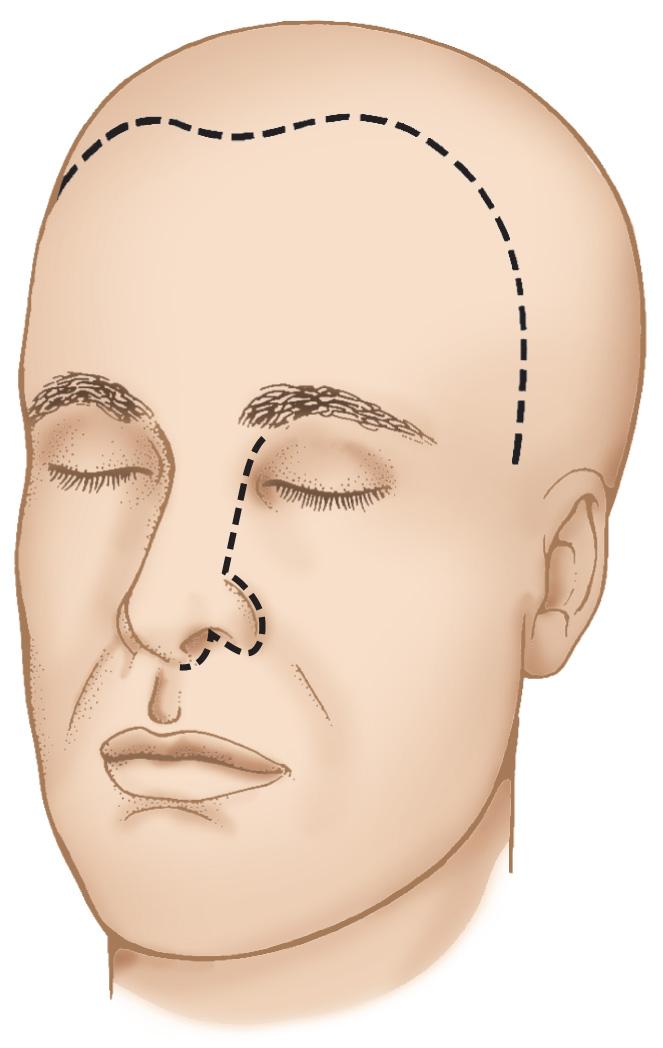
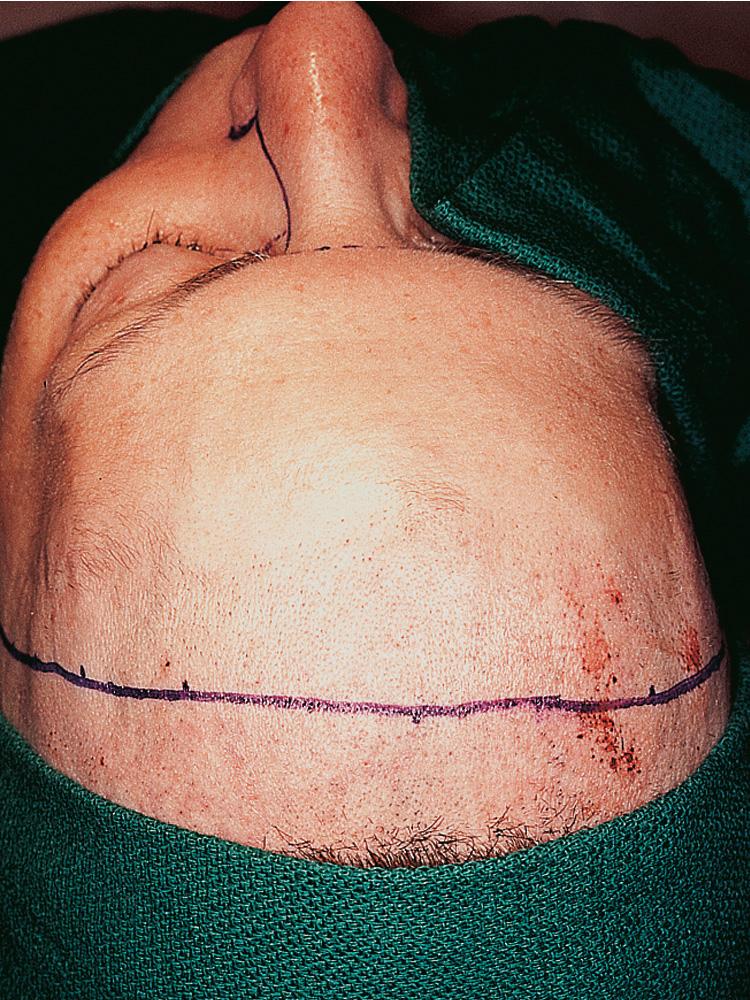
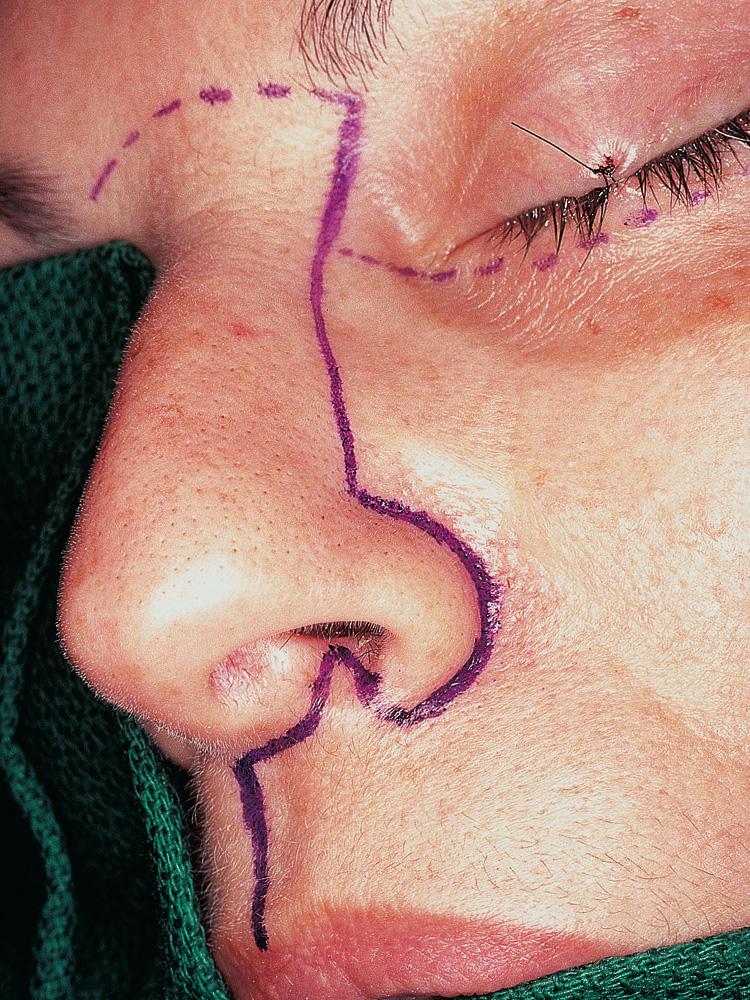
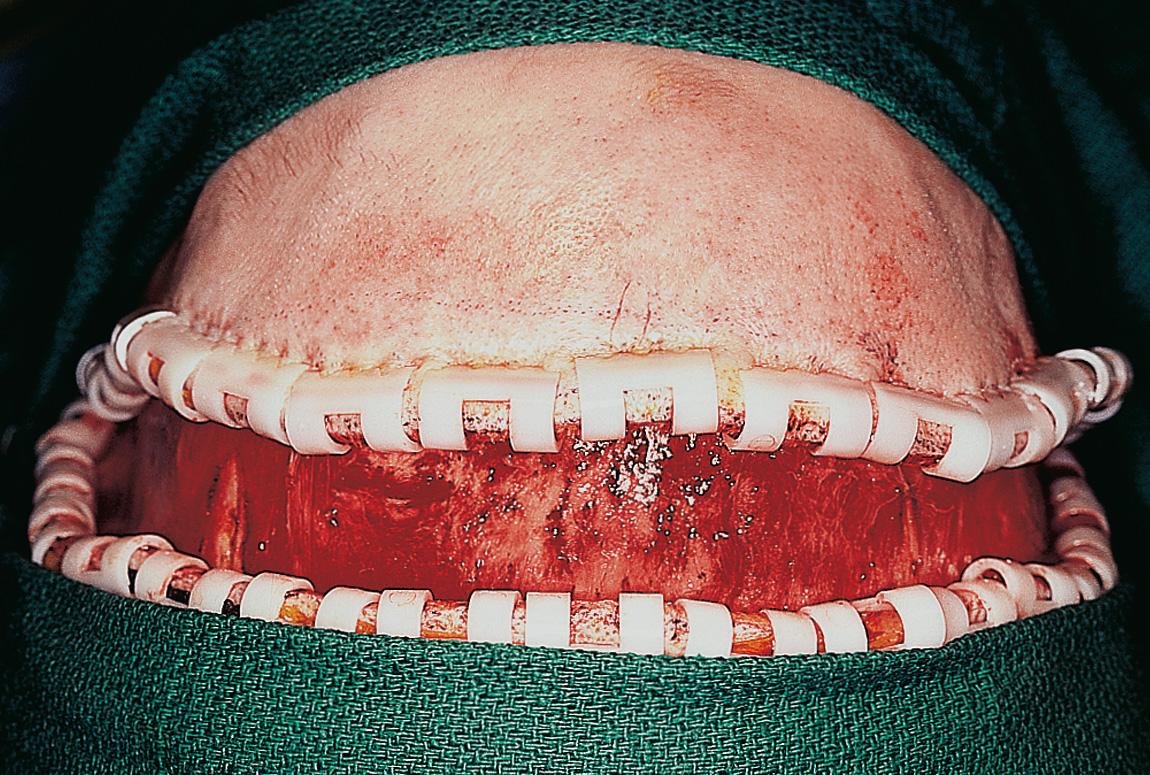
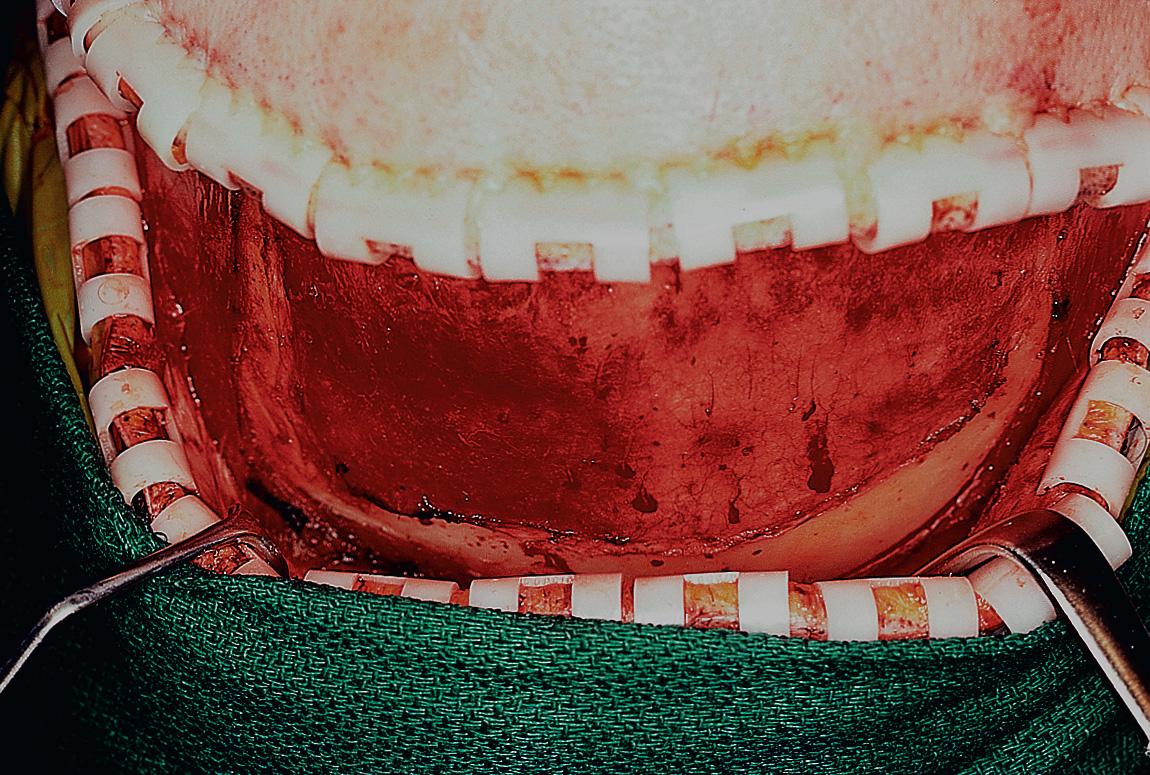
The proposed line of incision in the pericranium for the elevation of a pedicled galeal pericranial flap for subsequent use during repair of the skull base defect is shown in Fig. 6.38 . The incision in the pericranium has been made as previously described. Note that the posterior scalp flap is retracted significantly to obtain a generous length of the pedicled galeal pericranial flap. With use of a periosteal elevator, the pericranium is then elevated very carefully over the calvarium all the way up to the supraorbital ridges. Extreme care should be exercised to avoid injury to the pericranium, causing “button holes.” The anterior scalp flap is elevated in a similar fashion but remaining superficial to the galea aponeurotica up to the supraorbital ridge. Careful elevation of the galeal pericranial flap requires sharp dissection with a scalpel between the subcutaneous tissue and the galea, as shown in Fig. 6.39 . The blood supply to the galeal pericranial flap comes from the supraorbital and supratrochlear vessels. Extreme care should be exercised as elevation of the galea approaches the supraorbital ridge to avoid any injury to the supratrochlear and supraorbital vessels. A long and robust flap is thus available for reconstruction of the skull base defect ( Fig. 6.40 ). Complete elevation of the flap over the calvarium thus exposes the underlying frontal bone ( Fig. 6.41 ). The pedicled galeal pericranial flap is shown elevated and lifted to reveal its available dimensions for repair of the surgical defect.
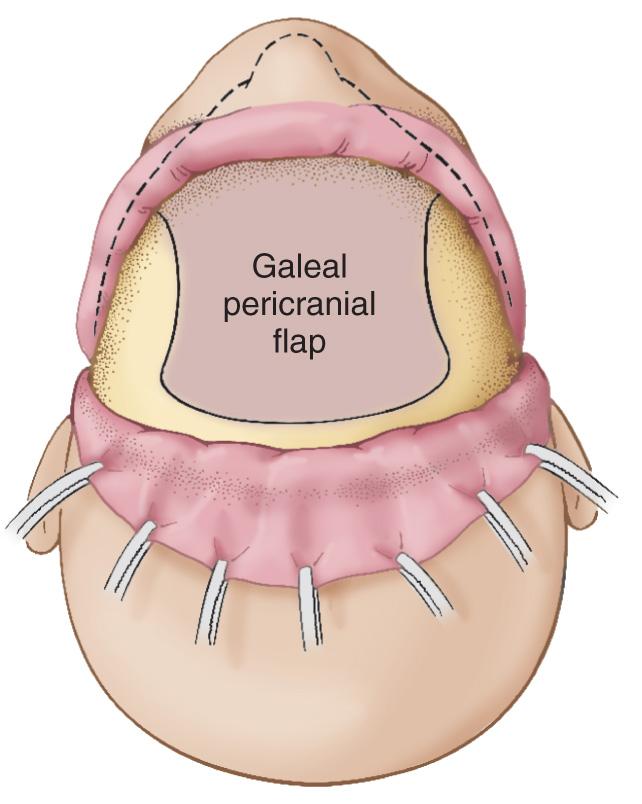
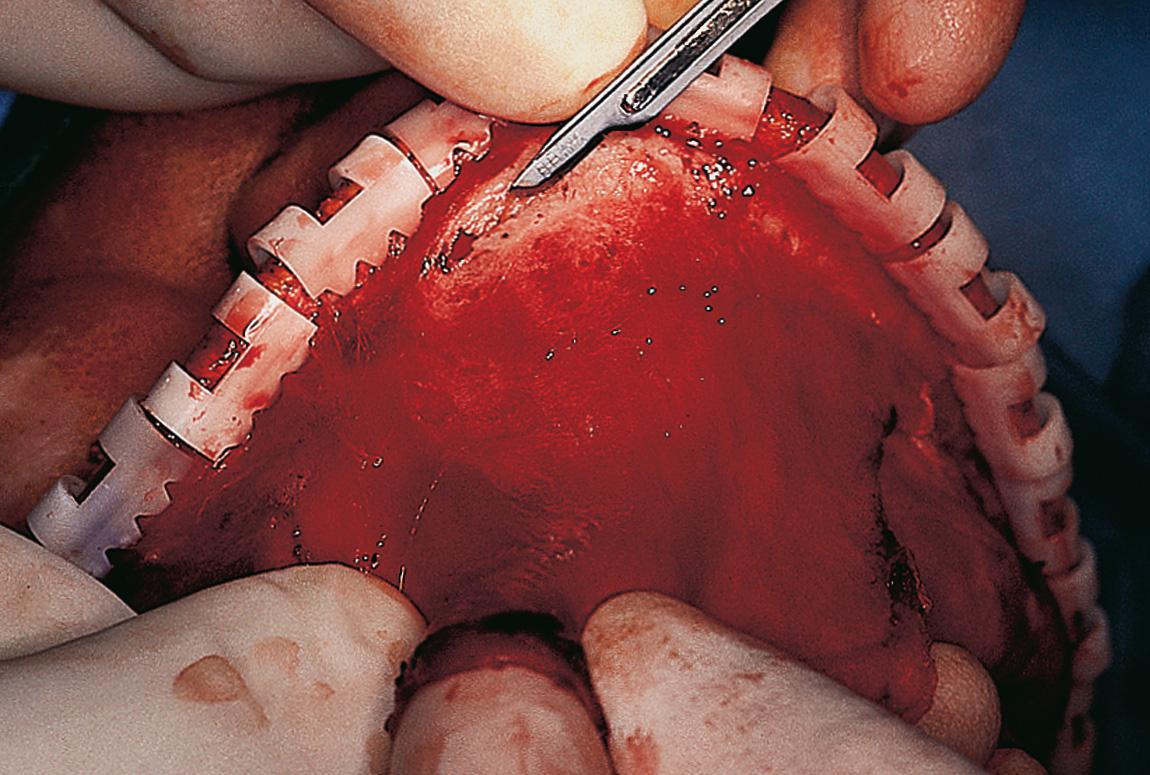
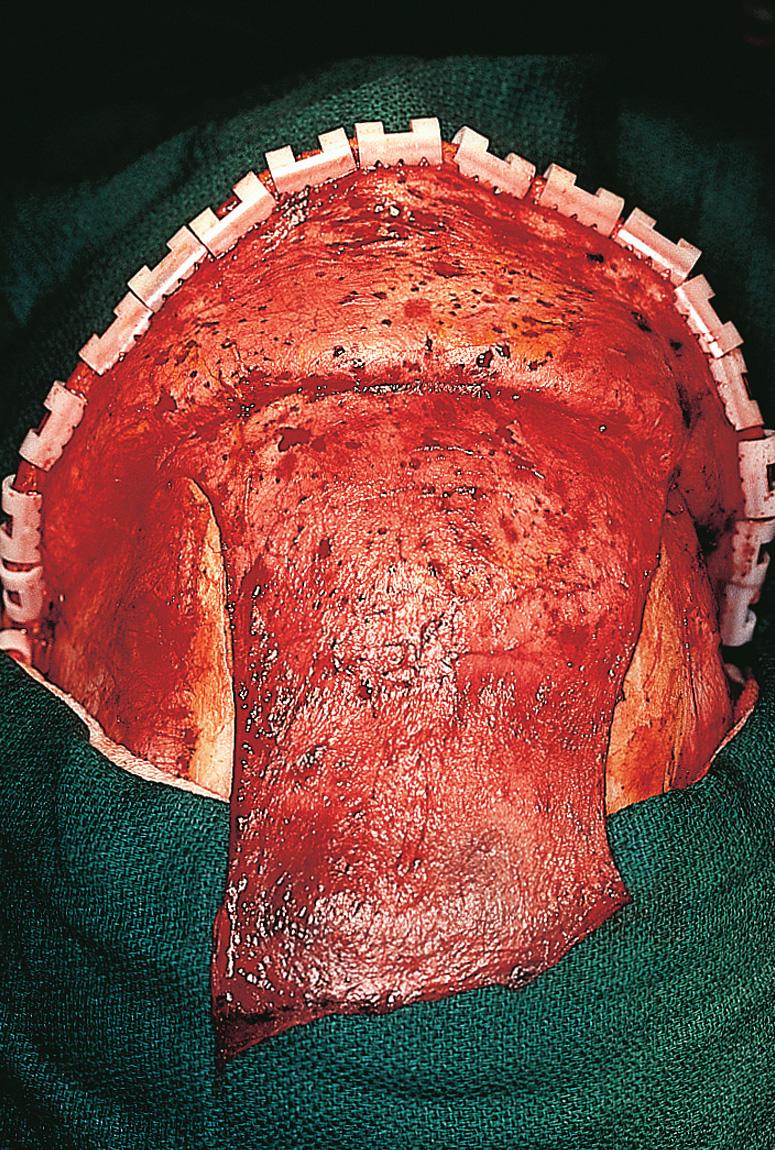
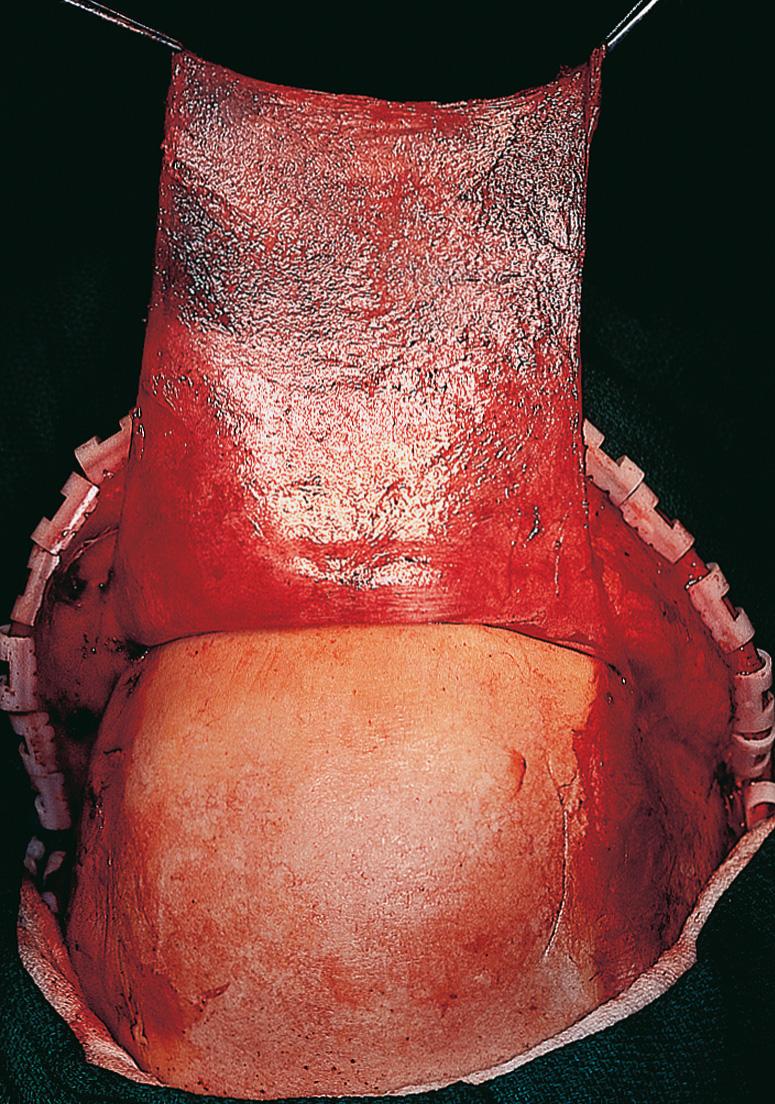
Elevation of the anterior scalp flap is carried out as far down as possible to expose the glabellar region and the upper half of the nasal bones. A retractor placed in the center of the field shows the exposed upper part of the nasal bones and the supraorbital ridges bilaterally ( Fig. 6.42 ). The proposed line of bone cut is marked out on the anterior wall of the frontal sinus and the frontal bone ( Fig. 6.43 ). A limited craniotomy of this dimension is satisfactory to get the necessary exposure for a subcranial approach to the cribriform plate.
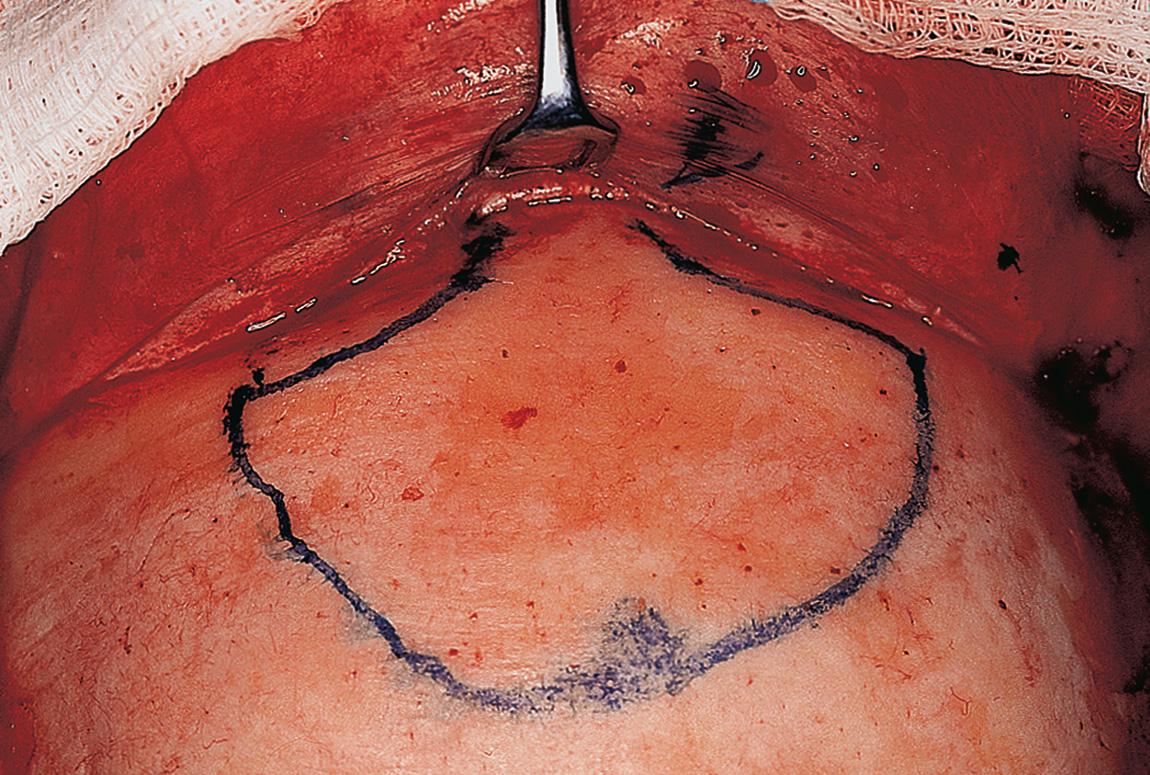
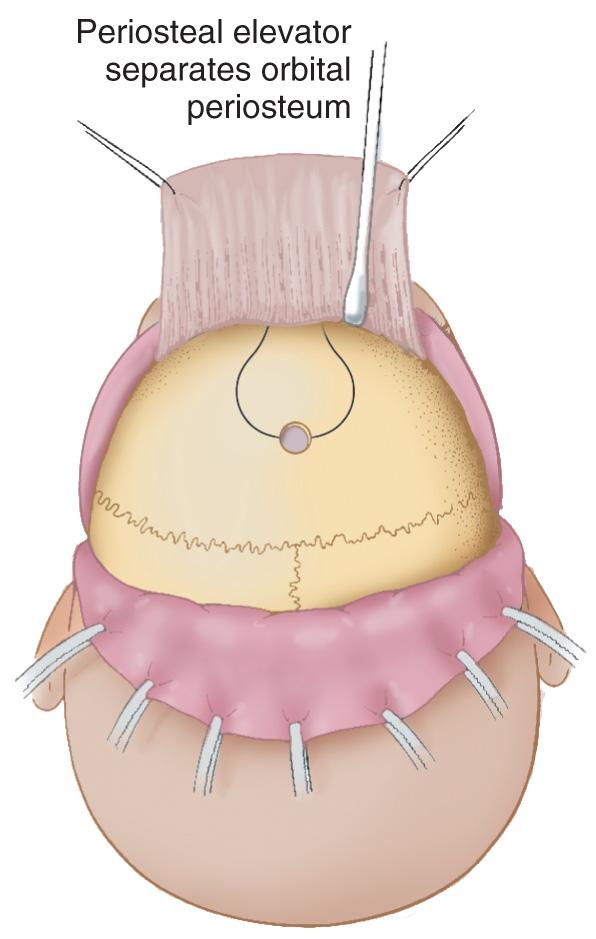
A craniotome is used to make a single burr hole in the midline. Dural elevators are used to elevate the dura adjacent to the burr hole on both sides to permit introduction of the side-cutting Midas Rex saw to complete the craniotomy ( Fig. 6.44 ). A circumferential bone cut is made at the proposed line of the craniotomy ( Fig. 6.45 ). Inferiorly only the anterior wall of the frontal sinus is cut with the side-cutting saw to complete the craniotomy ( Fig. 6.46 ). An osteotome is used to elevate the bone flap. The septum in the frontal sinus is fractured, and the bone flap is carefully elevated without injury to the underlying dura. Removal of the bone flap exposes the dura over the frontal lobes as well as the frontal sinus ( Fig. 6.47 ). The bony septa in the frontal sinus are removed with a rongeur and forceps. All the sharp bony spicules are smoothed out with a high-speed burr. The mucosa of the sinus is completely curetted out, and its posterior wall is removed to cranialize the frontal sinus ( Fig. 6.48 ). The openings of the nasofrontal ducts are plugged with Gelfoam.
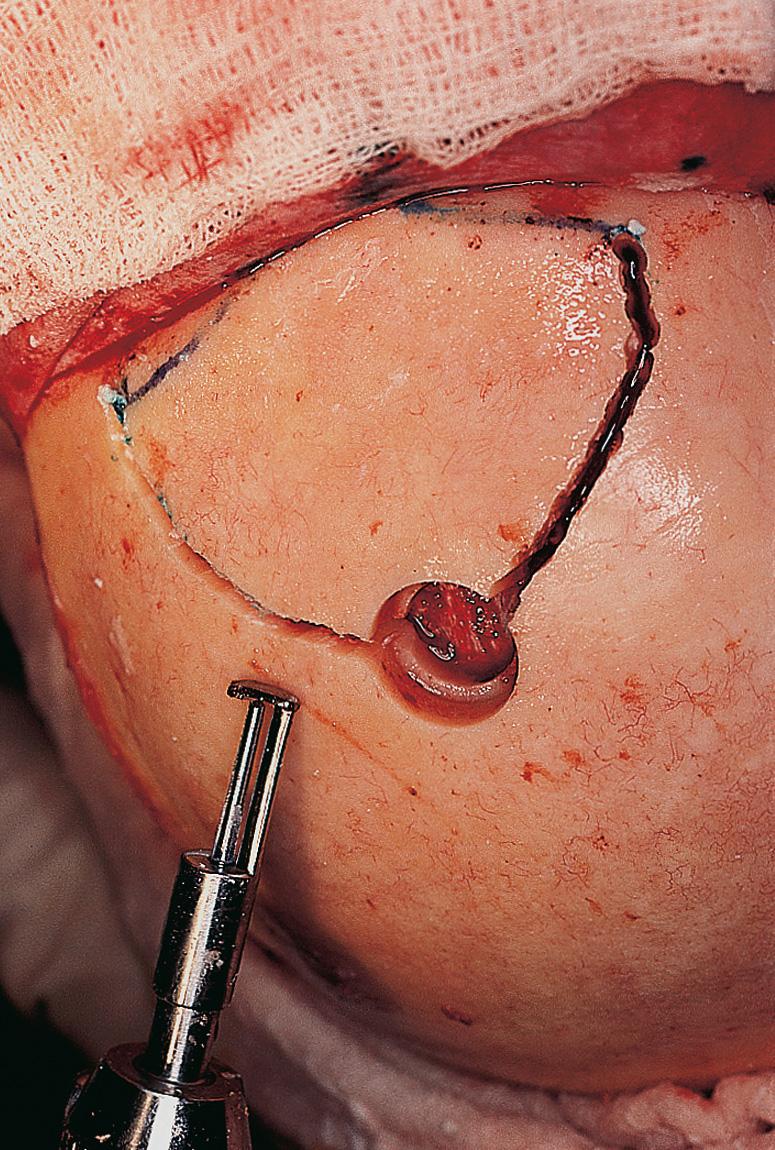
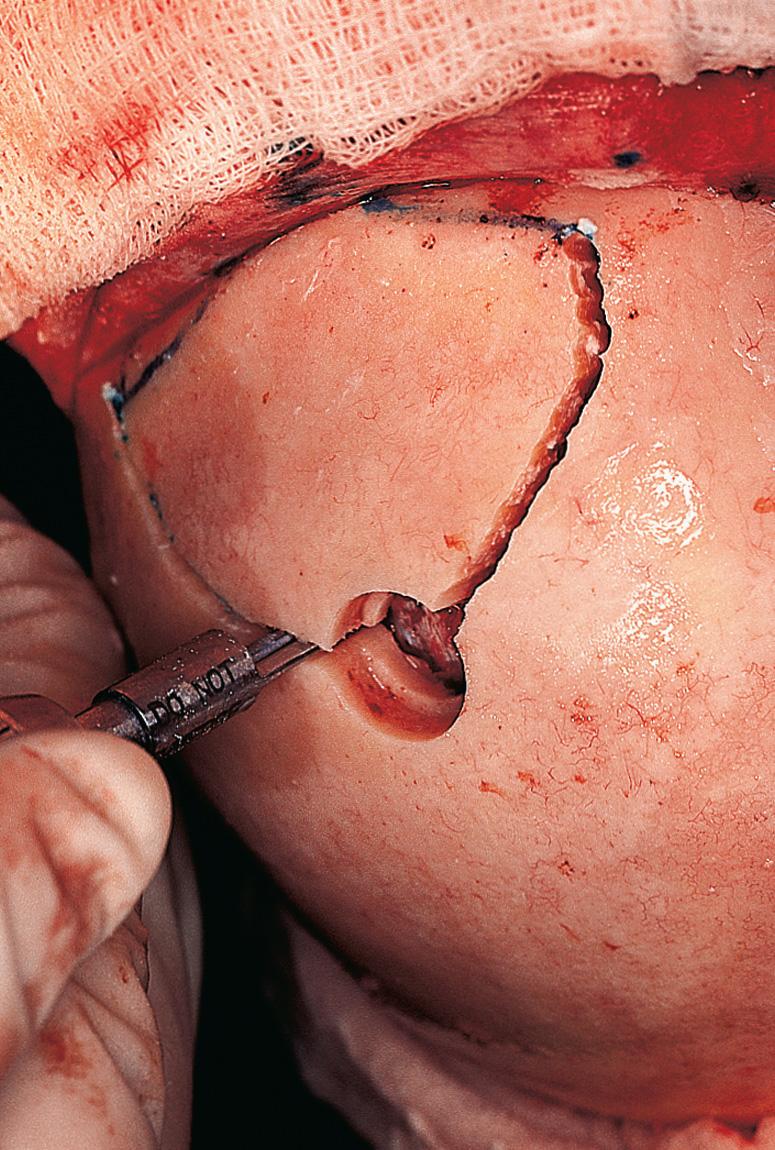
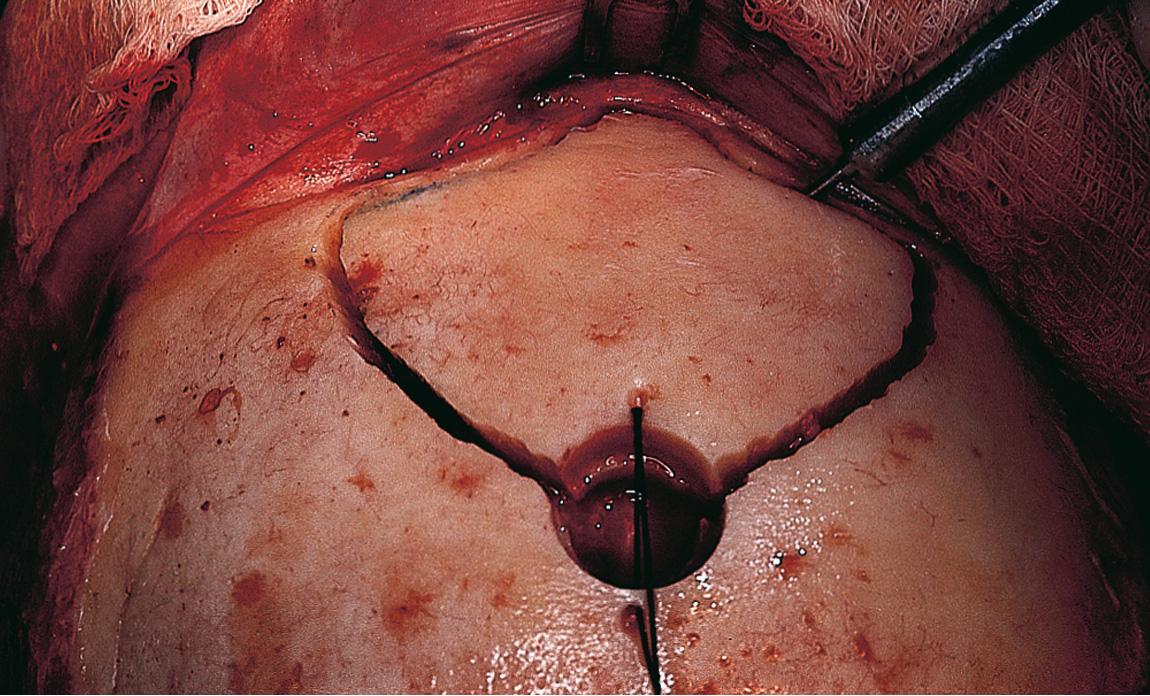
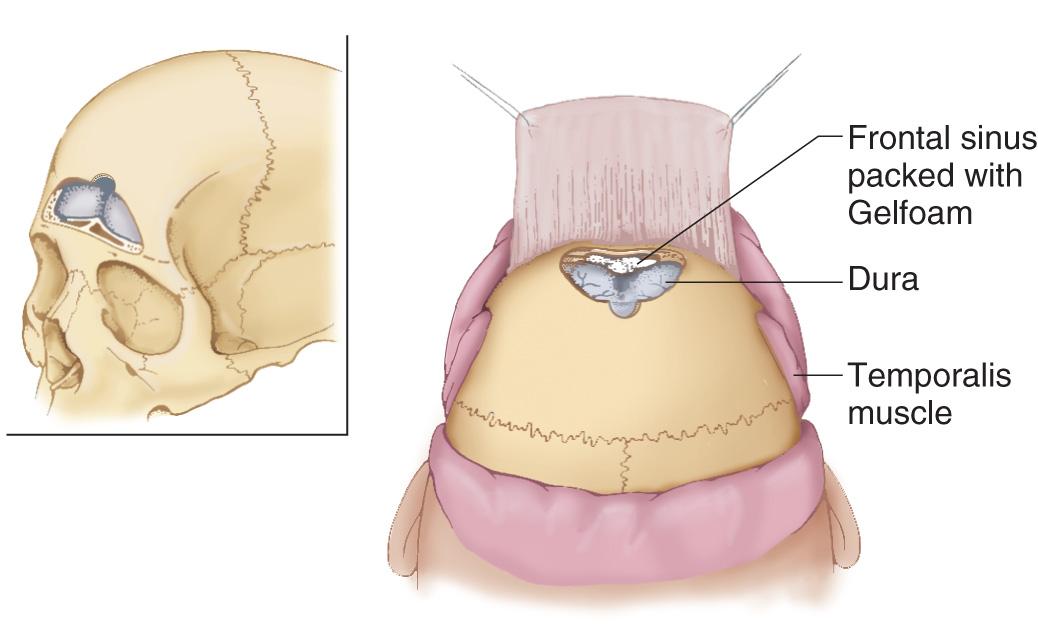
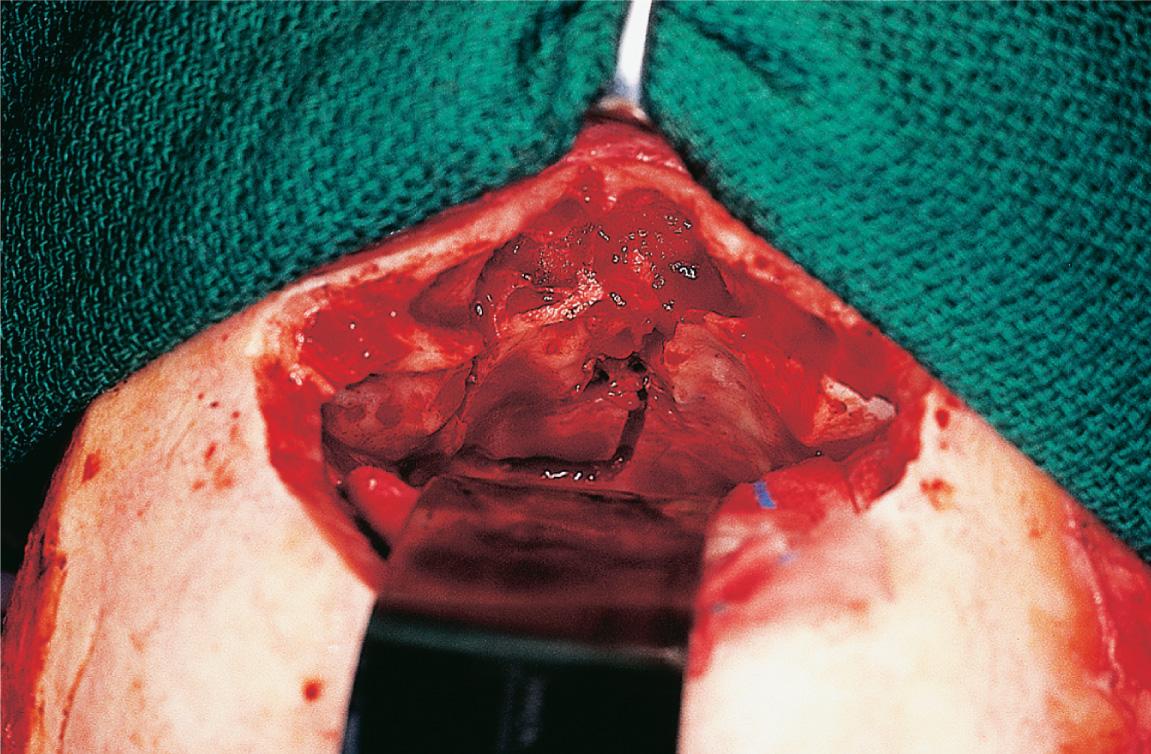
Attention is now directed to elevation of the dura from the floor of the anterior cranial fossa ( Fig. 6.49 ). Attachments of the dura to the crista galli require sharp division. The dural sleeves along the olfactory nerves are individually divided and ligated. The exposed crista galli, after elevation of the dura, is excised with a rongeur. Meticulous attention should be paid to avoid inadvertent tears in the dura during removal of the crista galli. Any tears that occur are immediately repaired with 4-0 Nurolon sutures. Attention is now directed to the dural sleeves that contain the olfactory nerves traversing the cribriform plate. Each dural sleeve is individually identified, dissected, divided, and ligated. Immediate ligation of the dural sleeves is desirable to avoid contamination of the brain during subsequent phases of the operation. However, if part of the tumor is seen perforating through the cribriform plate at this juncture, then the dura is opened and the entire segment of dura overlying the cribriform plate, along with the dural sleeves of the olfactory nerves, are resected with the tumor. This procedure creates a dural defect at the anterior cranial base that is repaired with use of a free graft of pericranium in a watertight fashion. The patient described here has no extension of tumor through the cribriform plate.
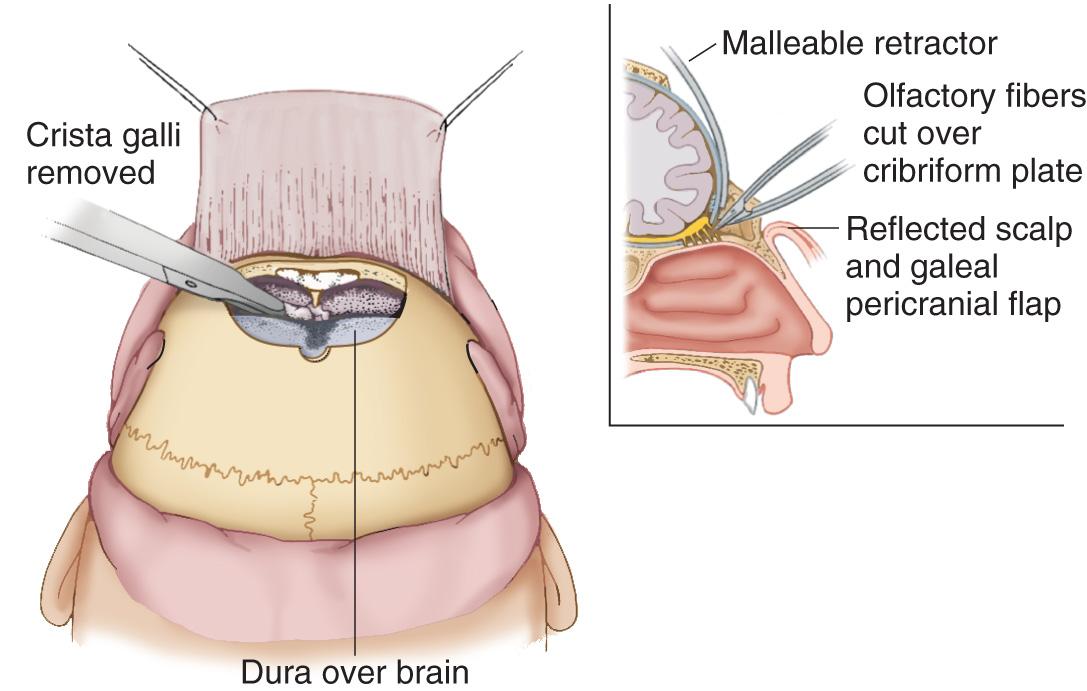
All the dural sleeves have been divided and ligated, as shown in Fig. 6.50 . Approximately 10 to 15 mL of cerebrospinal fluid is removed through the spinal catheter at this juncture to allow slackening of the brain. A retractor is used along the midline over the sagittal sinus to expose the posterior part of the cribriform plate and the planum sphenoidale ( Fig. 6.51 ). To ensure a complete seal of the sutured dural sleeves and any dural repairs, fibrin glue is used to attain an additional protective layer of watertight closure ( Fig. 6.52 ). The gel formed by mixing the fibrin glue components is shown in Fig. 6.53 .
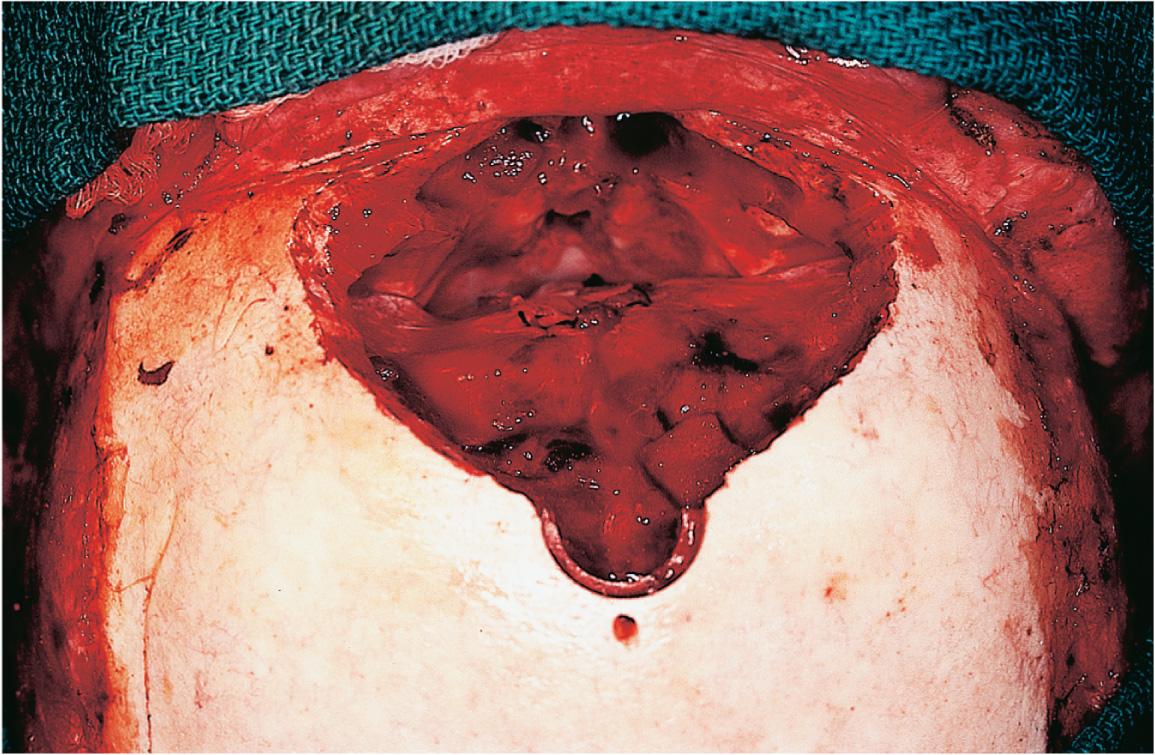
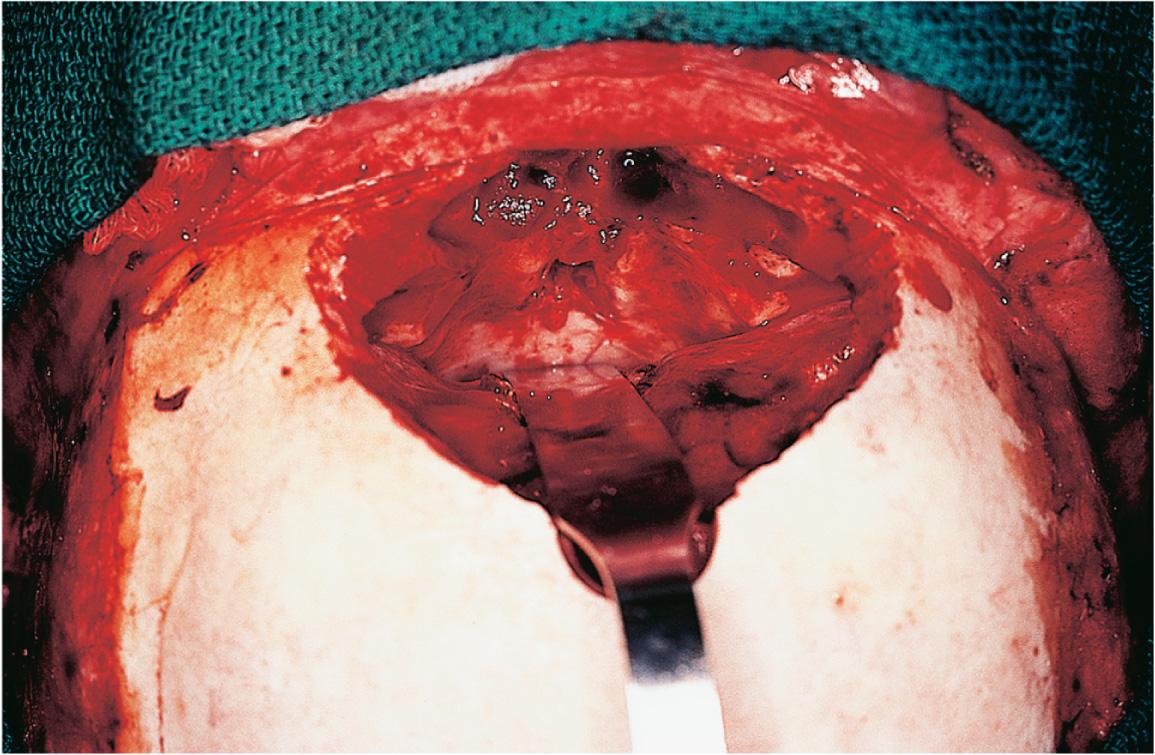
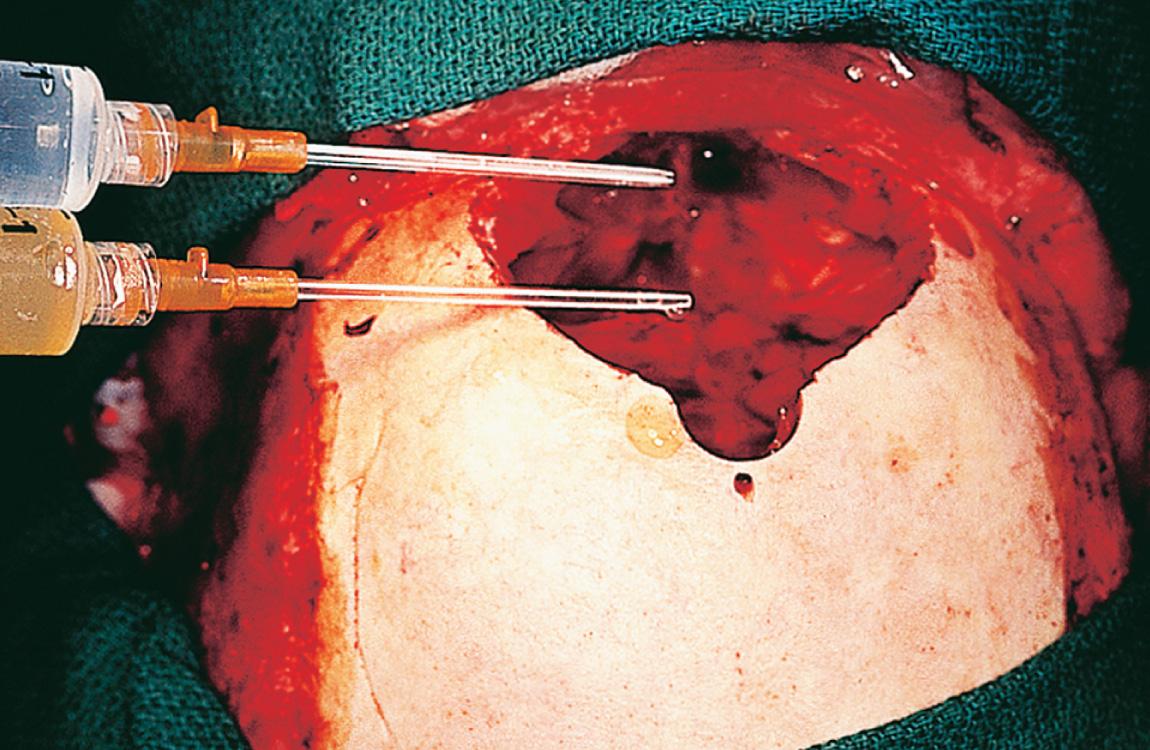
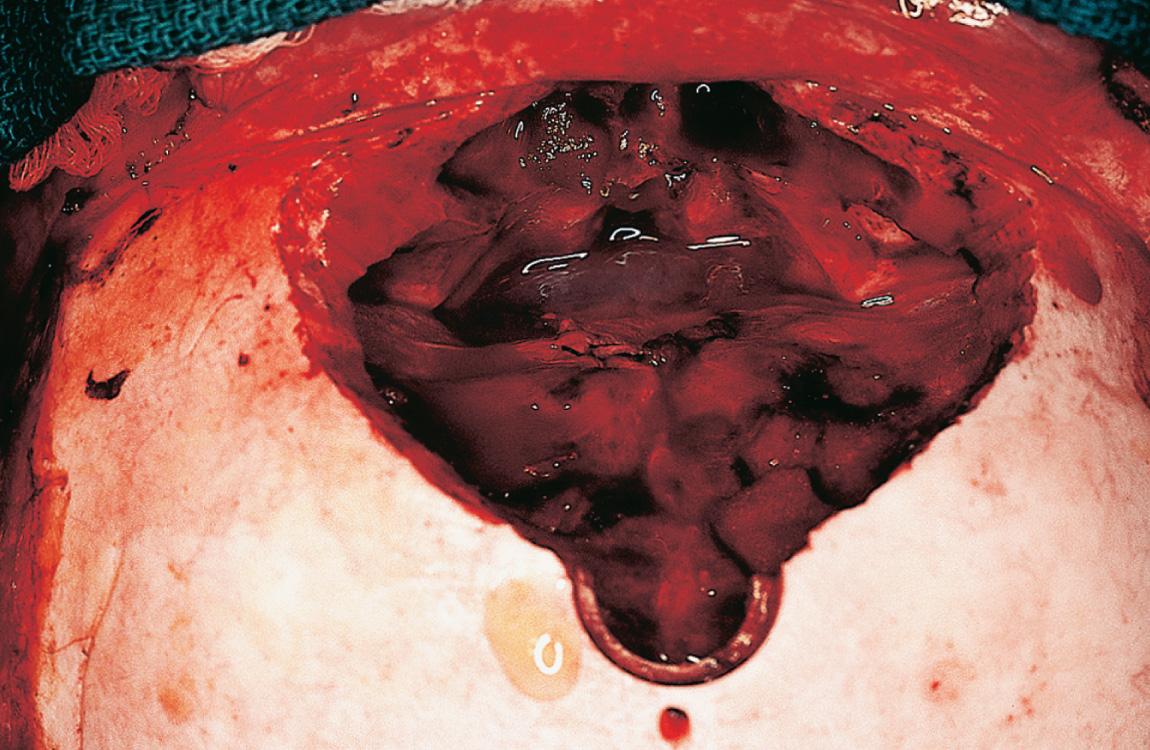
After adequate slackening of the brain is achieved, a wide malleable retractor is used to protect the frontal lobes in the midline posteriorly to gain wide exposure of the planum sphenoidale and the cribriform plate. A high-speed drill with a fine burr is now used to make the bone cuts through the floor of the anterior cranial fossa ( Fig. 6.54 ). The circumferential bone cut around the cribriform plate is completed. Note that the bone cut goes through the roof of the left orbit, remaining lateral to the lamina papyracea on the left side, through the sphenoid sinus posteriorly, and through the cribriform plate, remaining medial to the lamina papyracea on the right-hand side and through the frontal sinus anteriorly to encompass the superior aspect of the surgical specimen. At this juncture, the first phase of the operative procedure through the craniotomy is complete.
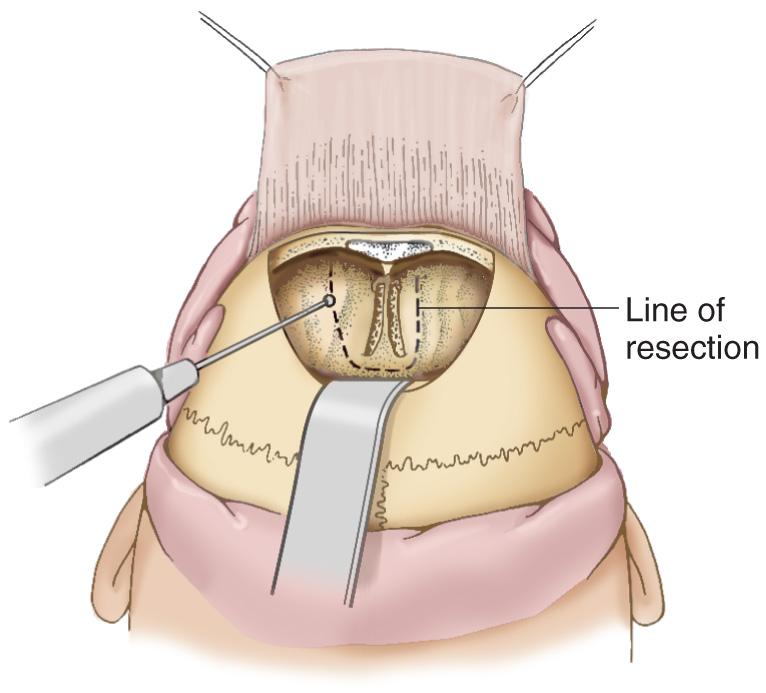
The facial approach begins with a modified Weber-Ferguson incision that is extended up to the medial aspect of the eyebrow on the left-hand side ( Fig. 6.55 ). The skin incision goes through the full thickness of the soft tissues and musculature of the nasolabial region.
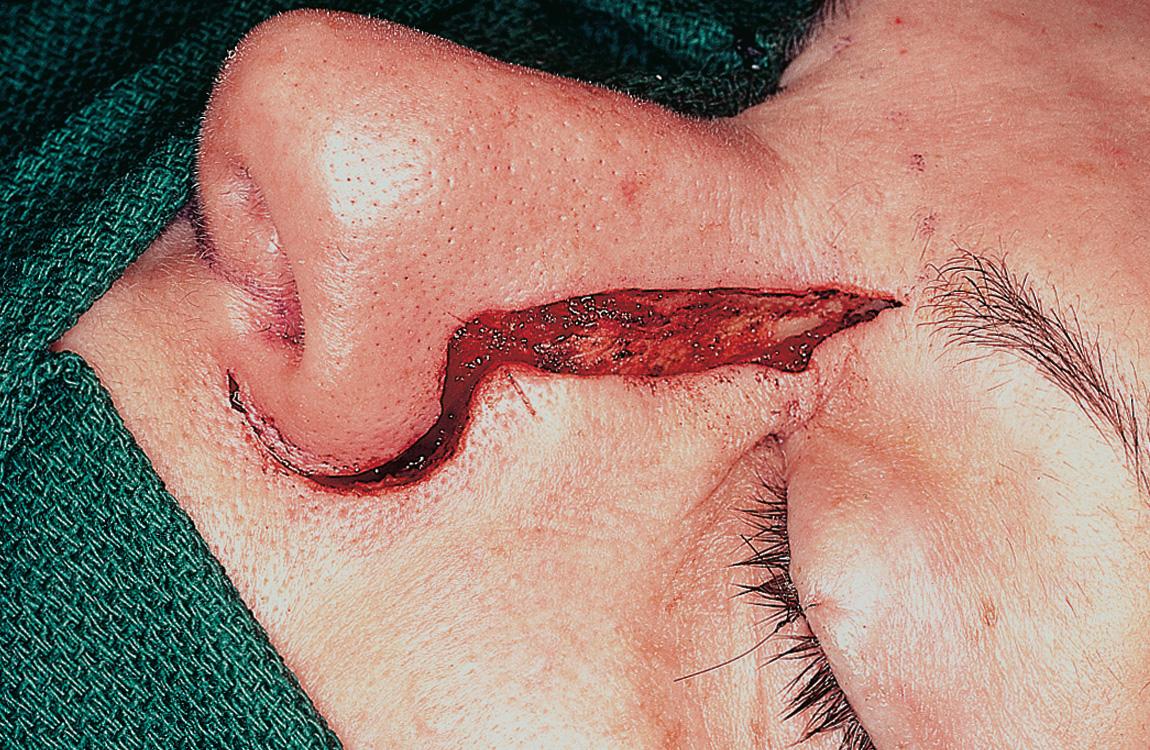
The periosteum of the medial wall of the orbit is elevated to keep the contents of the orbit within its periosteal envelope. Attachment of the medial canthal ligament is identified ( Fig. 6.56 ). The medial canthal ligament is detached and retracted with a 4-0 Nurolon suture, which subsequently will be used for its fixation to the nasal bone during closure ( Fig. 6.57 ). The nasolacrimal duct is dissected out of its fossa with use of fine periosteal elevators ( Fig. 6.58 ), and a scalpel is used to divide the duct flush with the rim of the orbit. The cheek flap is elevated directly over the anterior bony wall of the maxilla, carefully preserving the infraorbital nerve as it exits from the infraorbital foramen ( Fig. 6.59 ). The orbital periosteum is elevated from the bony orbit in its medial half. A malleable retractor is introduced into the orbit, and the globe is retracted laterally. As the periosteum of the medial half of the orbit is elevated from the lamina papyracea, the anterior and posterior ethmoid vessels are encountered, coming from the orbital periosteum and perforating through the lamina papyracea. These vessels are carefully identified and electrocoagulated with a bipolar cautery. The mucosa of the nasal cavity is now incised through its lateral wall at the vestibule along the anteromedial wall of the maxilla ( Fig. 6.60 ), which provides exposure of the interior of the nasal cavity.
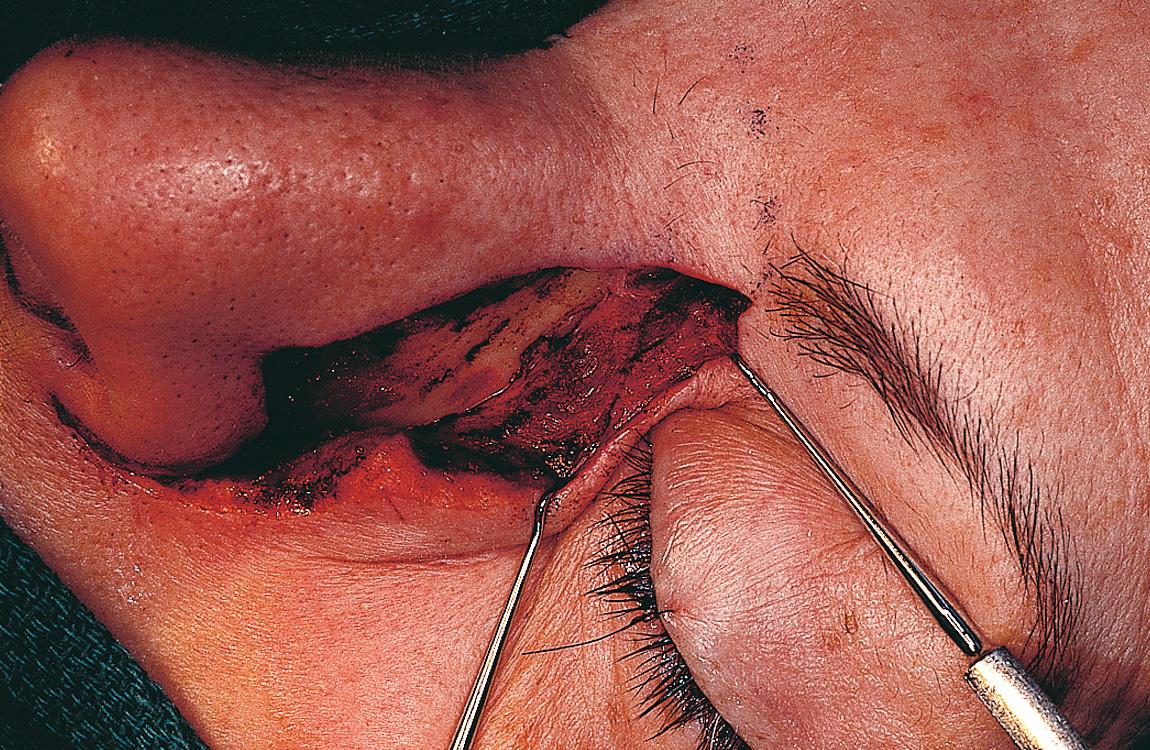
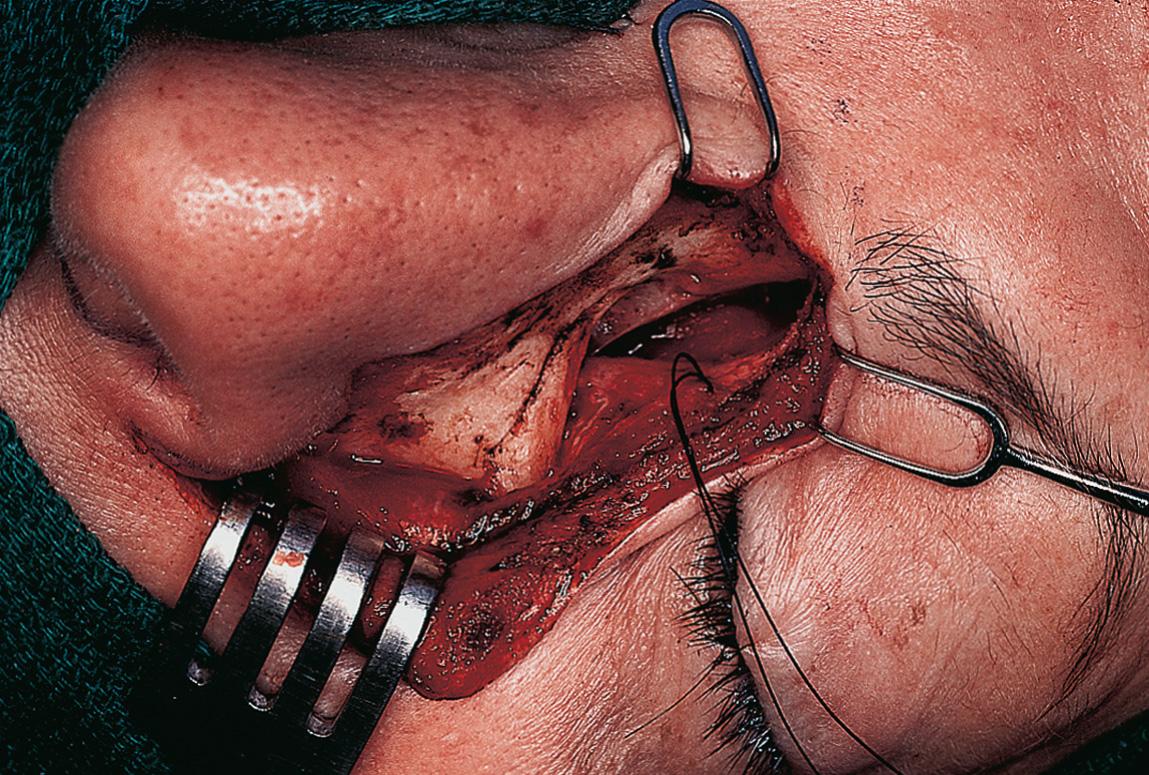
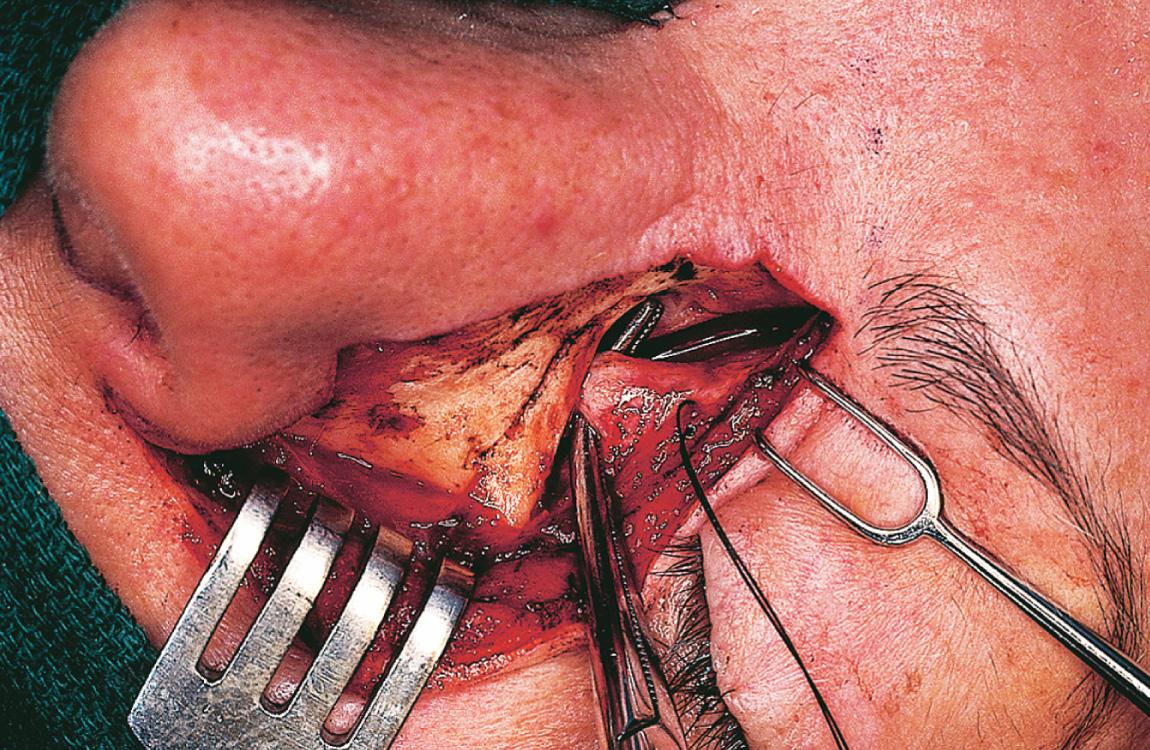
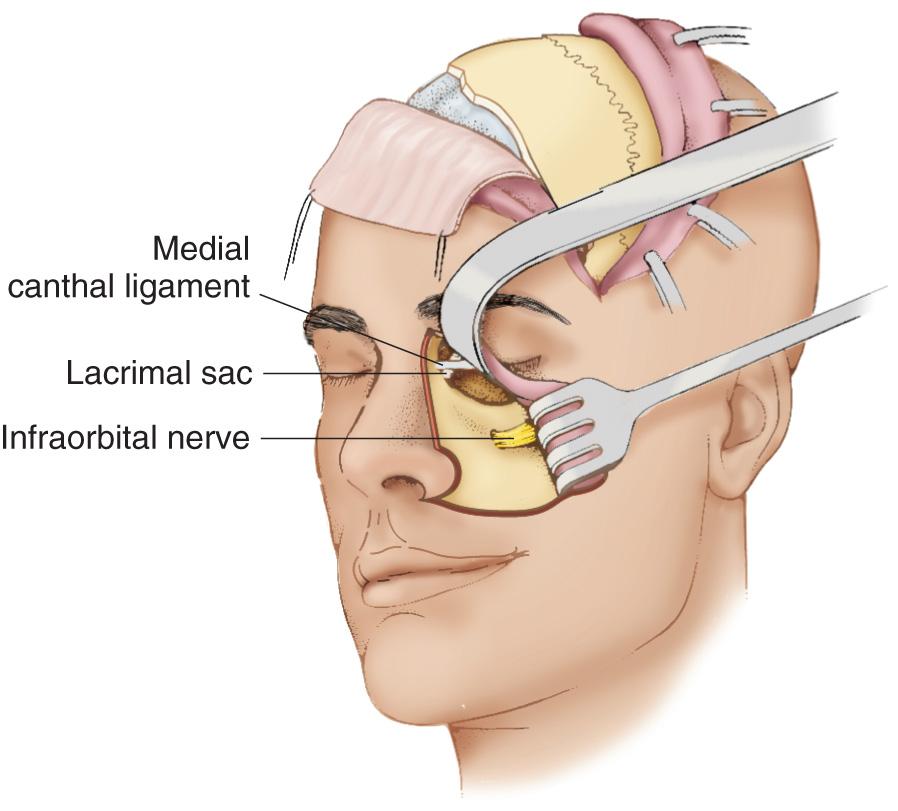
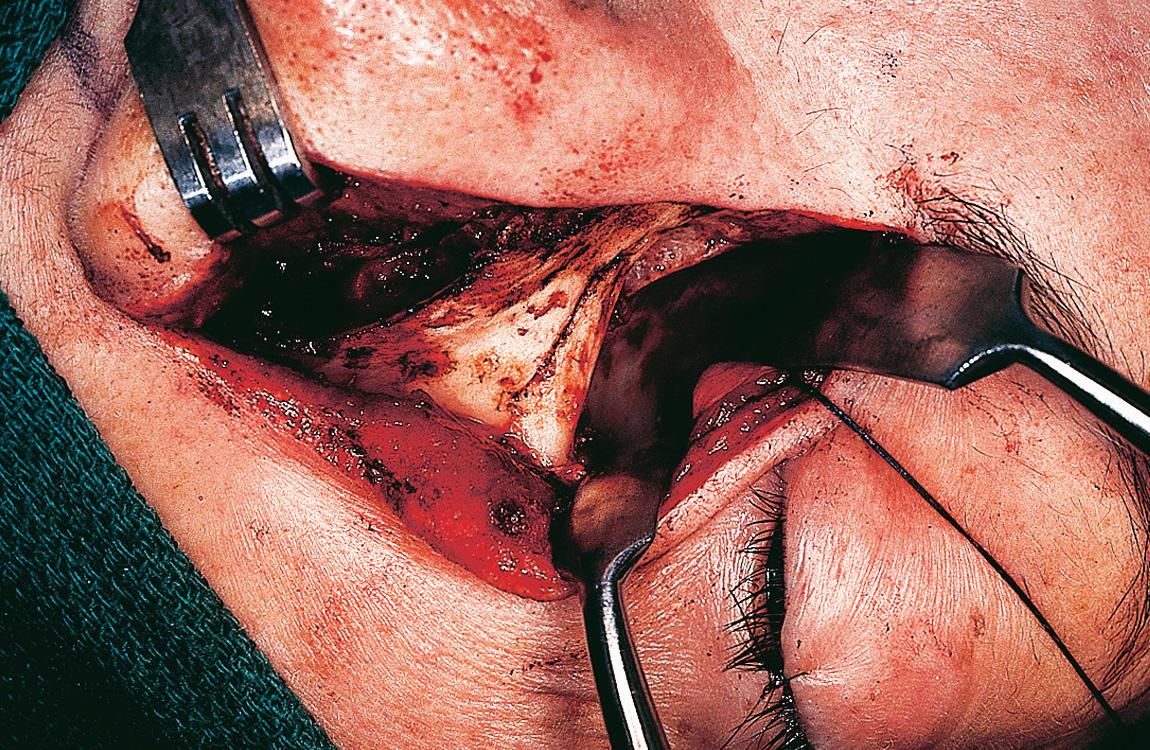
The anterior wall of the maxillary antrum is opened with use of a high-speed drill and a burr ( Fig. 6.61 ). The opening is enlarged enough to permit easy insertion of an index finger in the maxillary antrum ( Fig. 6.62 ). Careful inspection of the interior of the antrum is made to see if any tumor is present. No tumor could be seen in this patient. The skin and soft tissues of the nose are elevated over the nasal bones to gain further exposure of the region of the upper half of the nasal cavity. Bone cuts are now made through the nasal process of maxilla and through the lacrimal fossa and the anterior aspect of the lamina papyracea within the orbit on the left-hand side ( Fig. 6.63 ), which permits mobilization of the bony attachments of the lamina papyracea. These bone cuts are made with fine osteotomes and a high-speed drill with a fine burr. The medial wall of the maxilla in its lower part is divided with an osteotome through the floor of the nasal cavity as far back as posteriorly as possible.
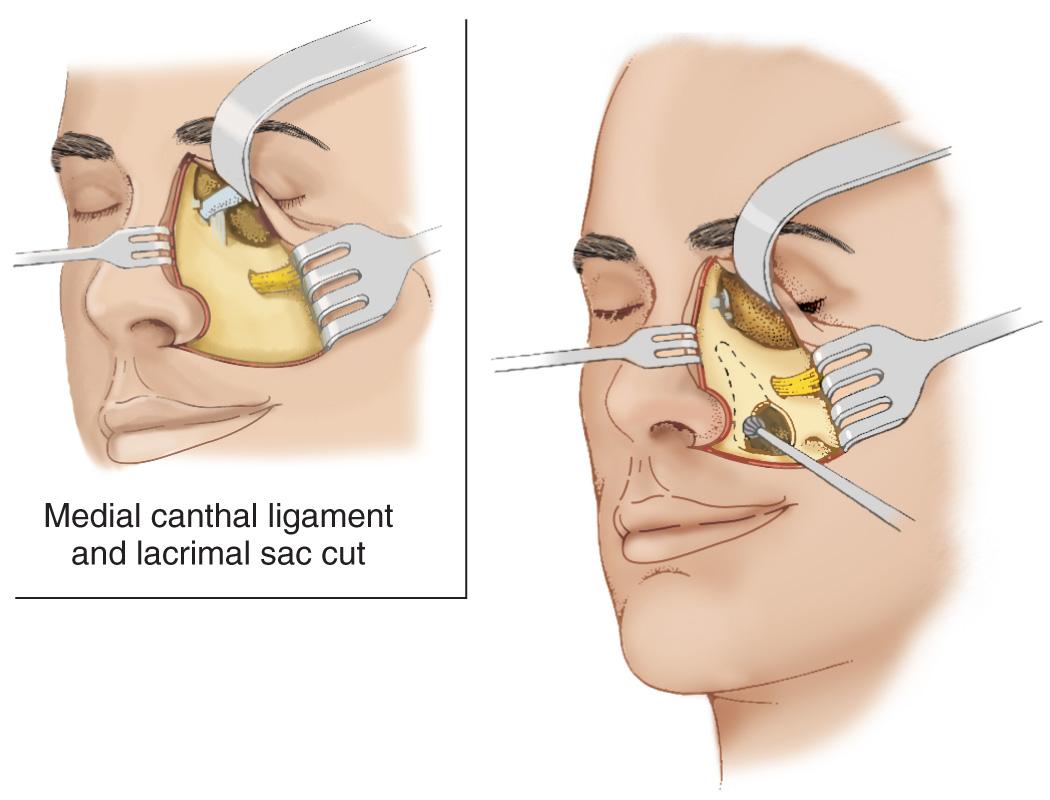
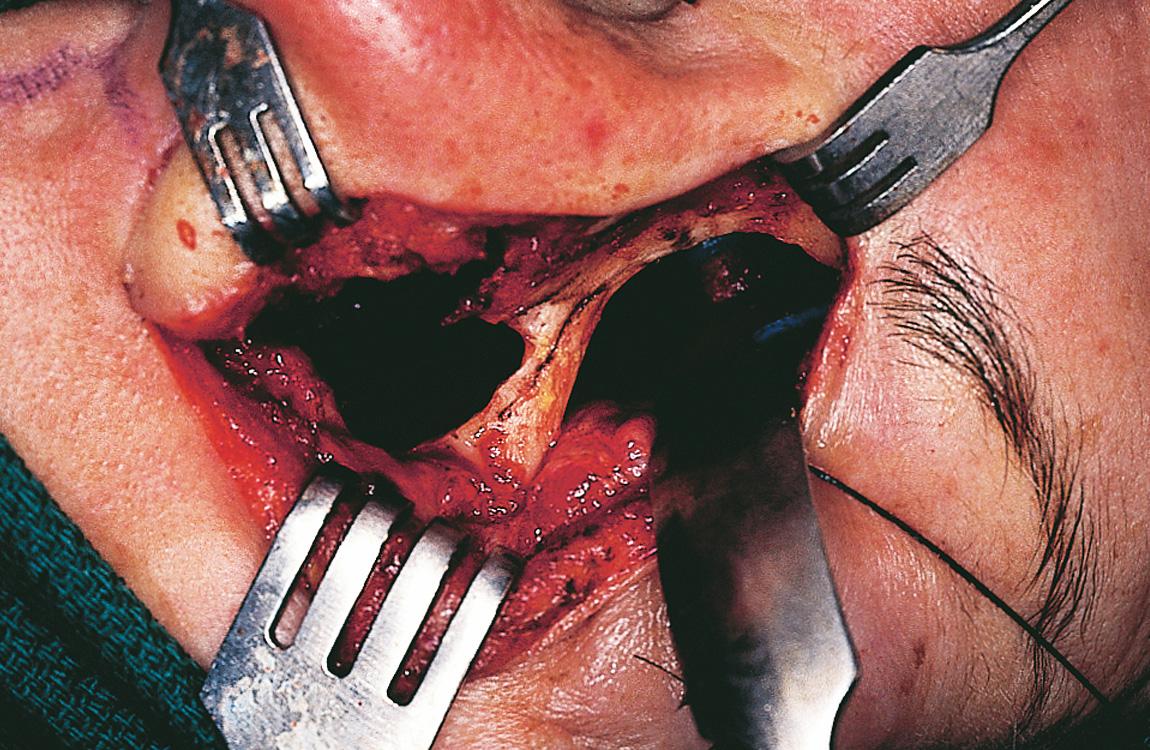
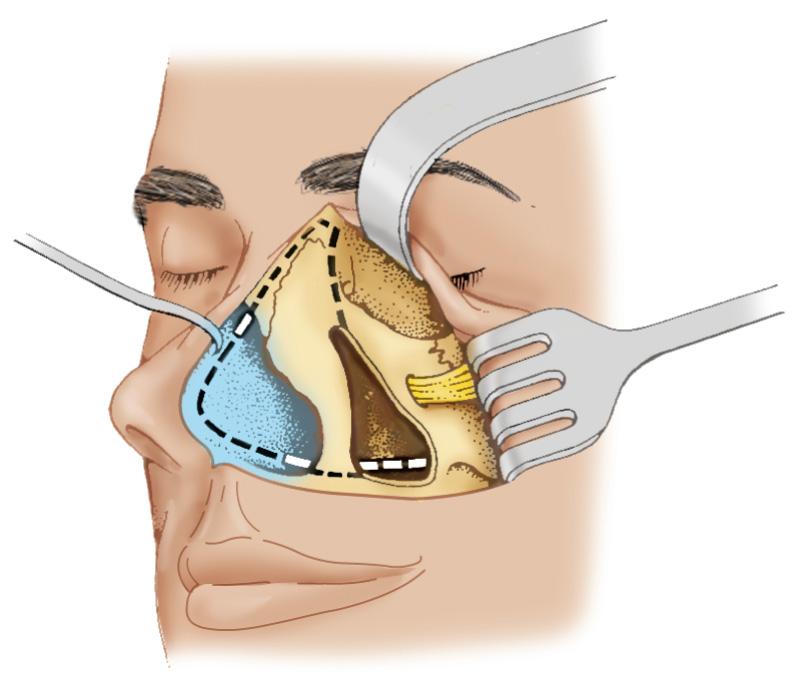
An incision is made in the nasal septum to complete medial mobilization of the surgical specimen and totally remove the contents of the nasal cavity. The incision in the nasal septum is made with an electrocautery, remaining approximately 8 mm posterior to the columella. The septal incision is completed through the floor of the nasal cavity all the way up to and including the vomer bone. This incision is accomplished with either an osteotome or heavy serrated scissors. Similarly, the incision in the nasal septum is carried cephalad along the bridge of the nose and the nasal bone, leaving a strip of the nasal strut to support the nasal framework in the lower half of the nasal cavity. Right-angled scissors are used to cut through the posterior aspect of the lateral wall of the nasal cavity ( Fig. 6.64 ). The scissors are introduced through the nostril and guided with a finger from the antrum to direct the cut cephalad. To remove the specimen safely, cranial exposure of the skull base is now necessary.
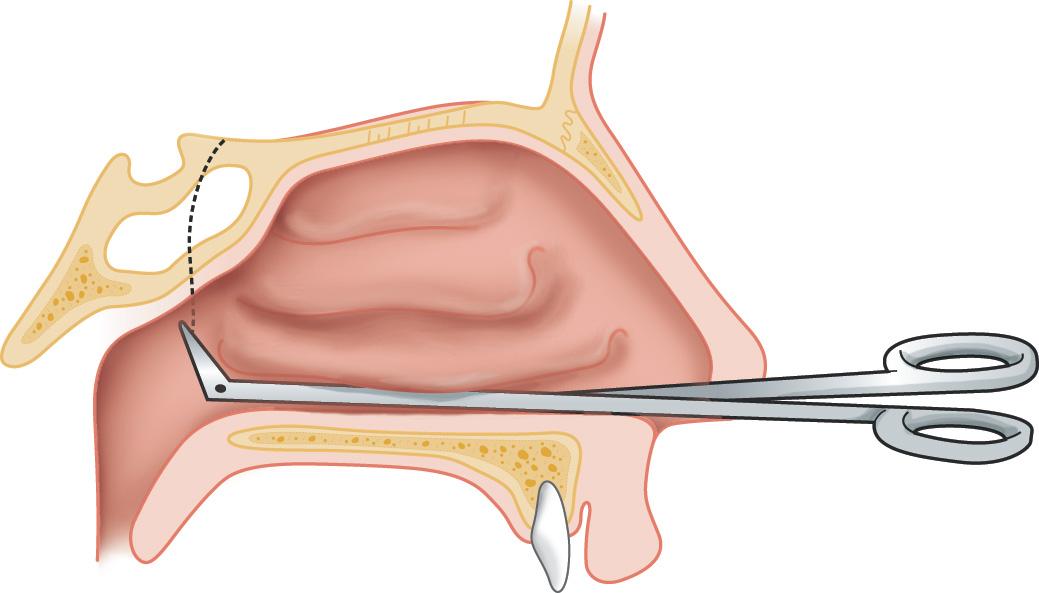
The intracranial aspect of the surgical field is now exposed. Under digital and visual guidance provided by the head and neck surgeon from the facial aspect, the specimen is removed. Straight osteotomes are used from the cranial cavity to separate the specimen laterally through the medial aspect of the left orbit and through the ethmoid air cells on the right-hand side as well as through the sphenoid sinus posteriorly ( Fig. 6.65 ). Gentle strokes with a mallet on the osteotome are necessary to complete the fracture of the remaining bony attachments to allow removal of the specimen.
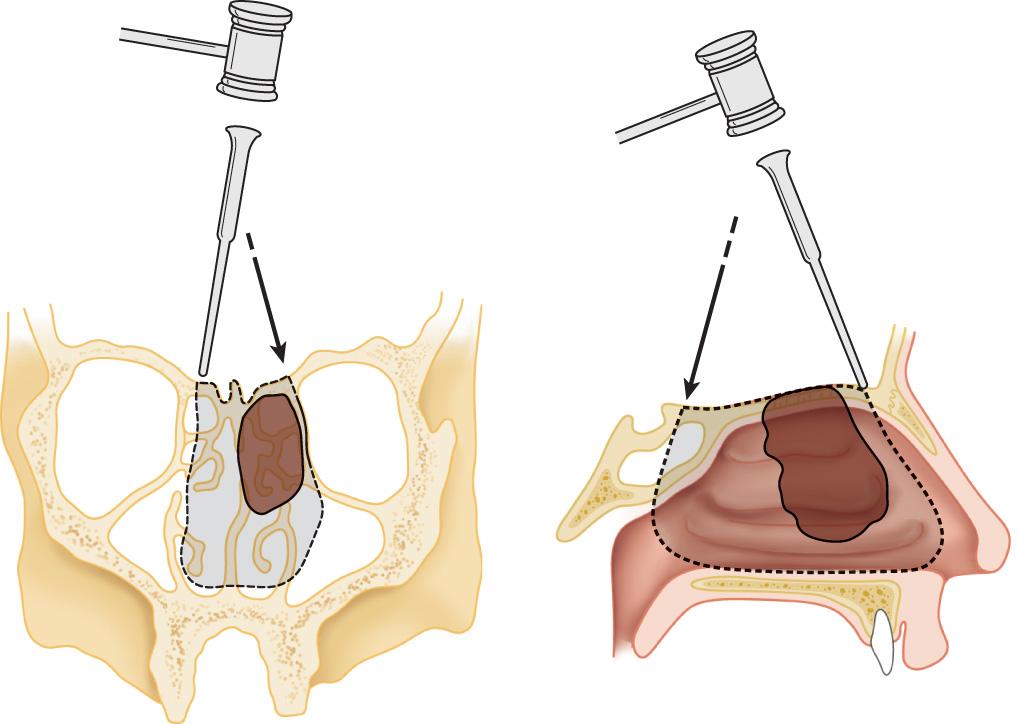
The surgical defect from the facial aspect shows complete exenteration of the nasal cavity and removal of its left lateral wall ( Fig. 6.66 ). The silk suture tagged to the medial canthal ligament overlies the upper eyelid. It must be resutured to the remaining nasal bone for repositioning of the medial canthus in its normal position. The medial canthal ligament is sutured through a drill hole to the left nasal bone with the 4-0 Nurolon suture. The point of fixation is matched to the opposite medial canthus. The surgical defect seen from the cranial cavity demonstrates a through-and-through resection of the bony floor of the anterior cranial fossa in the region of the cribriform plate ( Fig. 6.67 ).
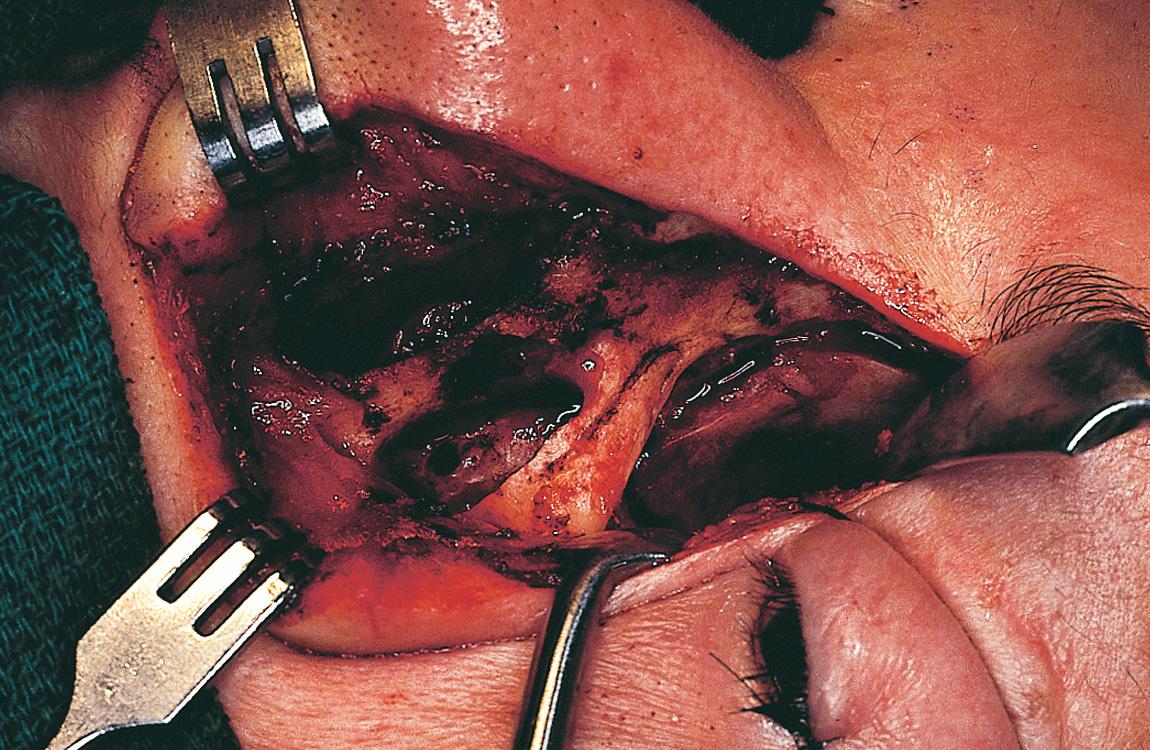
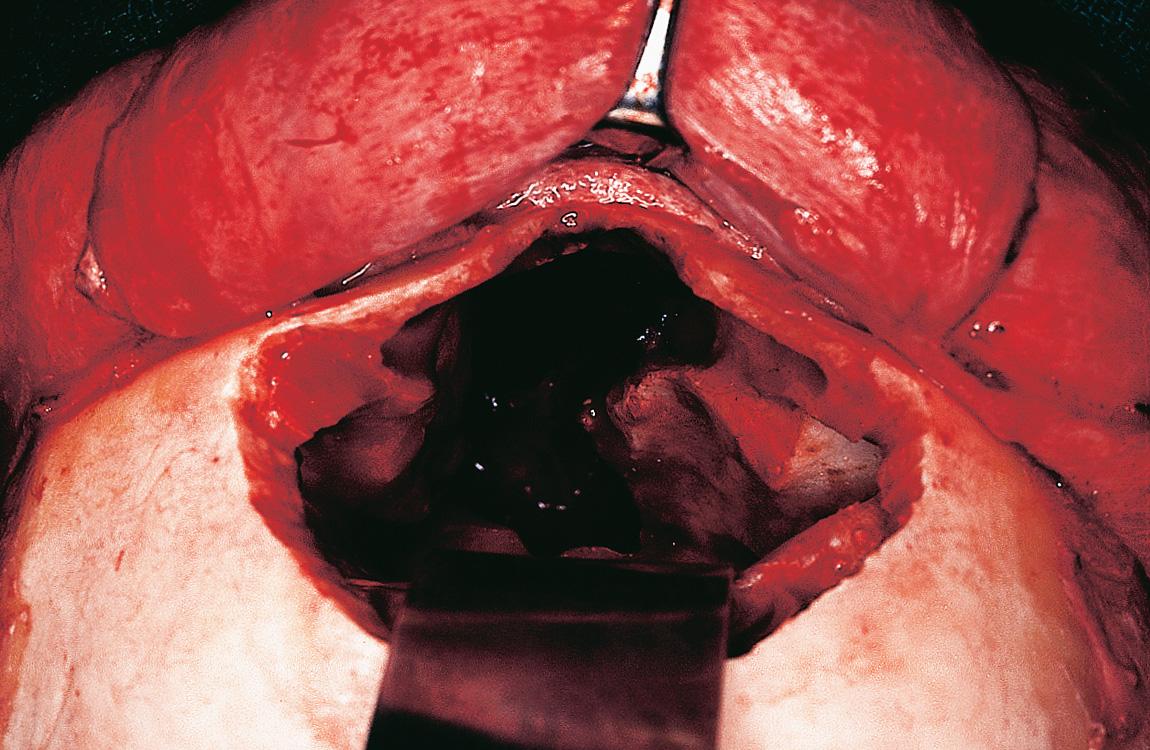
The previously elevated galeal pericranial flap is now brought into the field to cover the bony defect in the anterior skull base. Several drill holes are made in the posterior edges of the bony defect in the floor of the anterior cranial fossa. This procedure involves making drill holes through the roof of the orbit on the left-hand side, through the shelf of the bone along the right ethmoid air cells, and through the planum sphenoidale posteriorly.
A diagrammatic representation of how the galeal pericranial pedicled flap is swung down to cover the bony defect in the skull base is shown in Fig. 6.68 . The flap is sutured to the bony skull base, providing complete closure of the bony defect in the skull. Several interrupted sutures are taken between the galeal pericranial flap and the drill holes through the floor of the anterior cranial fossa ( Fig. 6.69 ). A secure closure and adequate support to the cranial base defect are thus achieved ( Fig. 6.70 ). The craniotomy is then closed with appropriate miniplates. A suction drain is placed through the burr hole in the extradural space, deep to the bone flap ( Fig. 6.71 ). The scalp incision is closed in the usual fashion.
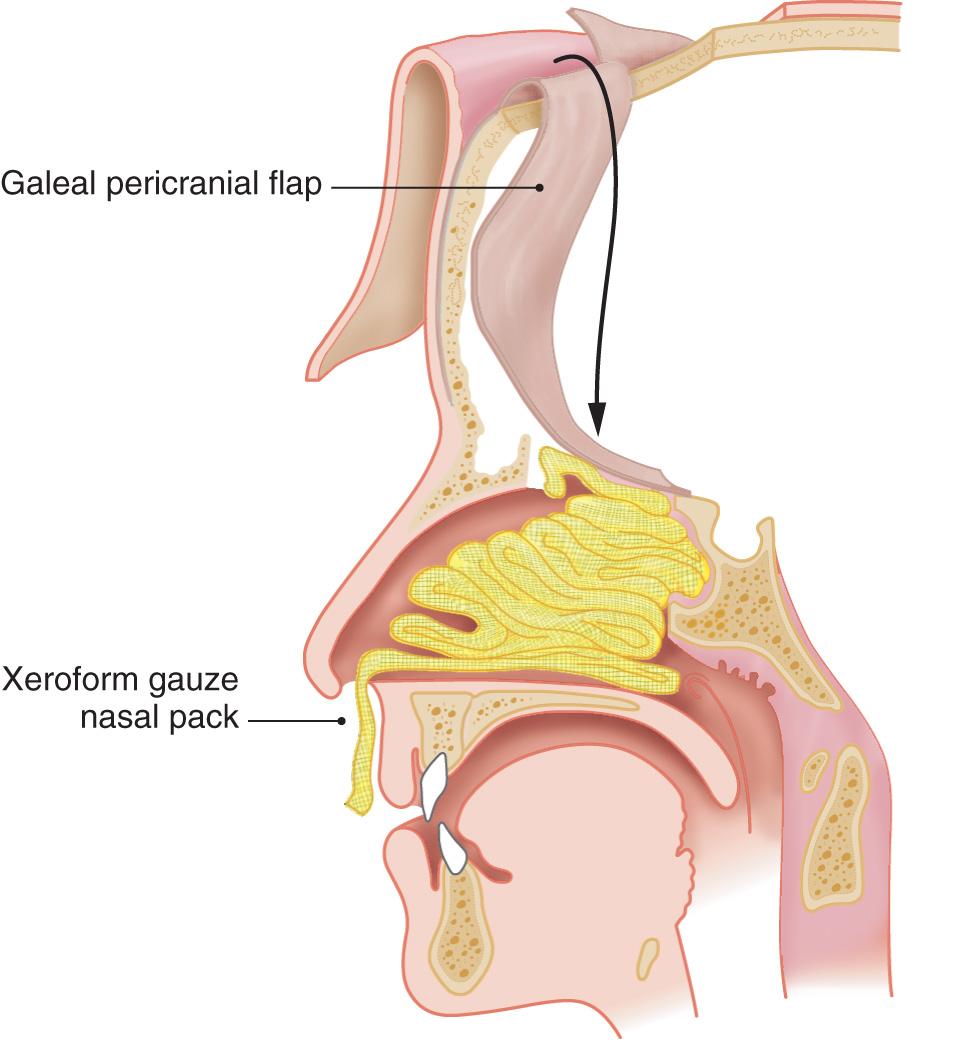
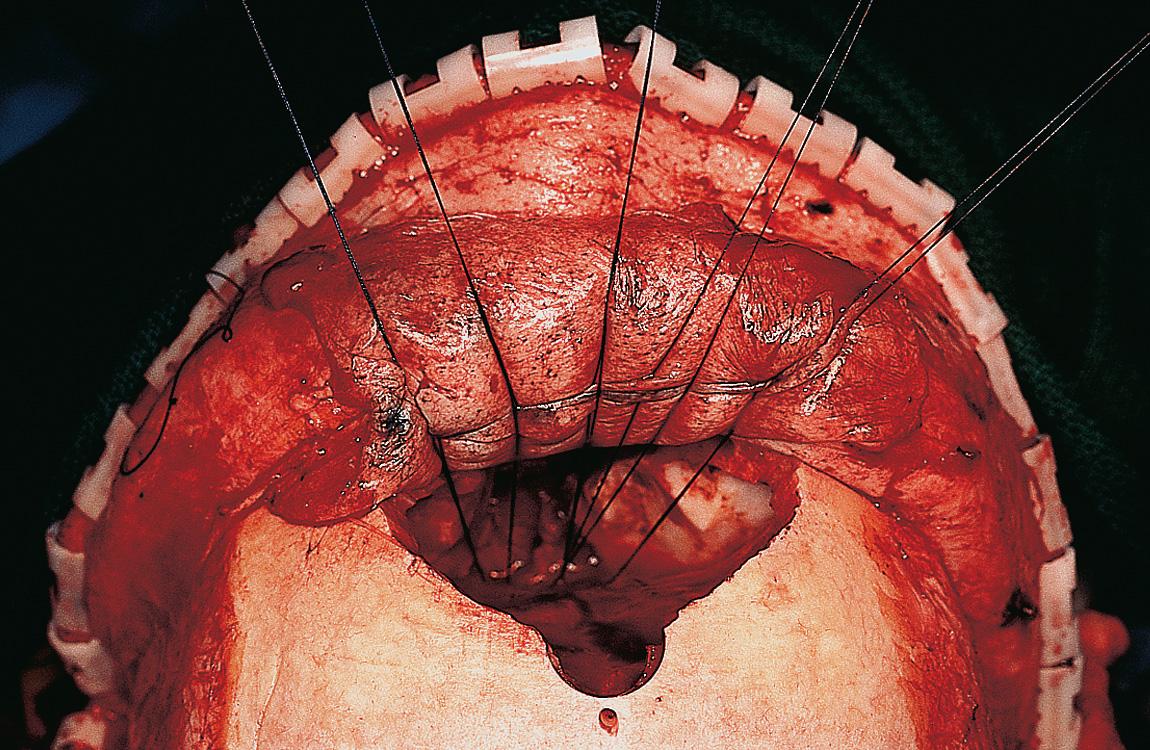
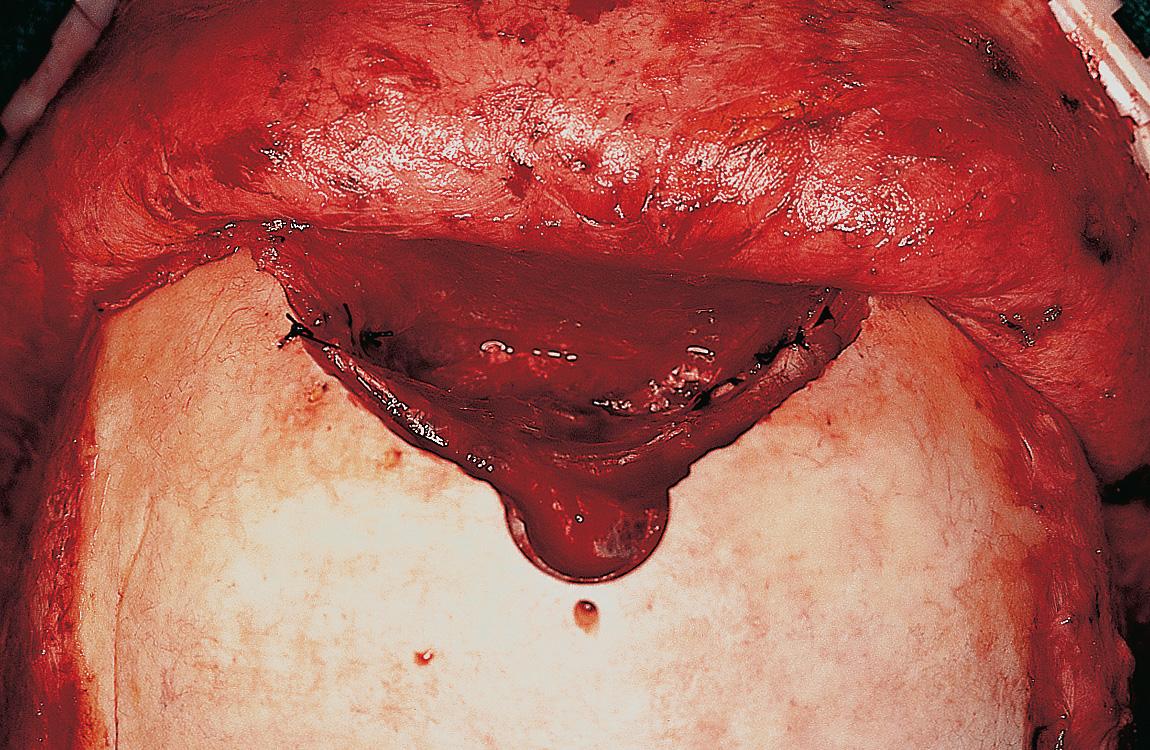
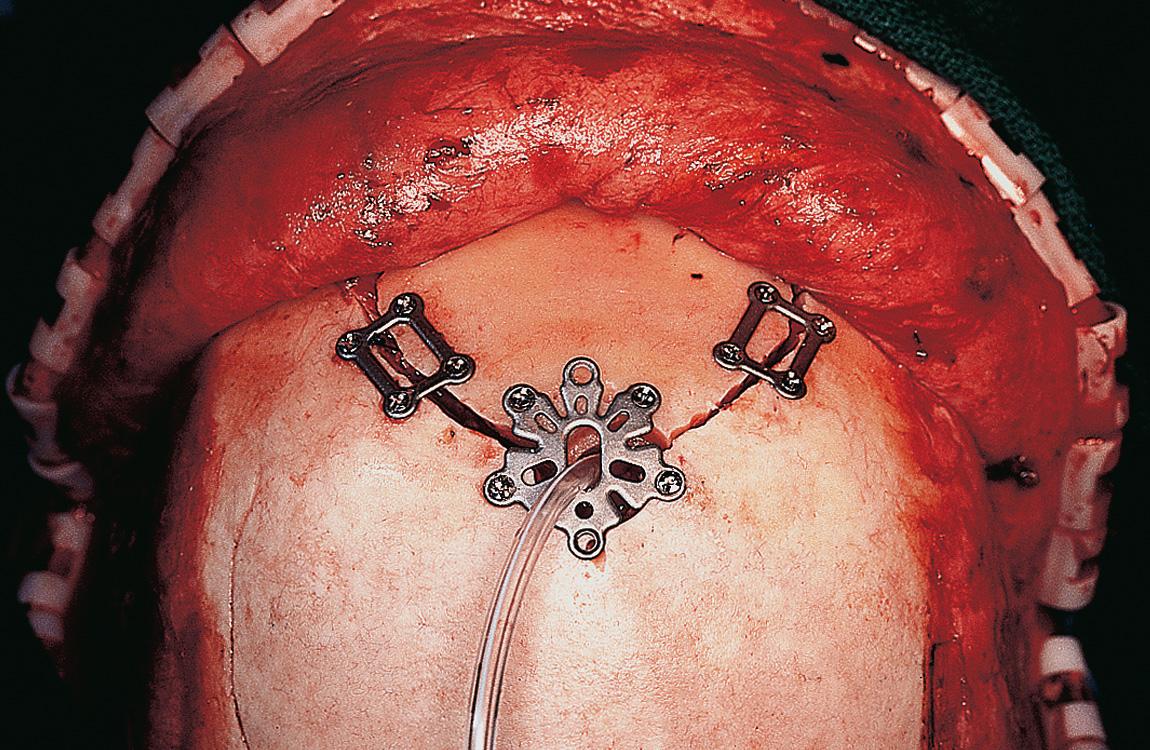
On the facial aspect, the puncta of the nasolacrimal duct are cannulated with a Silastic stent (see Fig. 6.72 ), the ends of which are knotted in place within the nasal cavity (see Chapter 4 for details). Xeroform roller gauze packing is introduced into the nasal cavity to provide support to the galeal pericranial flap from the nasal aspect. The packing is introduced snugly to fill up the entire nasal cavity and support the galeal pericranial flap cephalad and the periosteum of the orbit on the left lateral side. The packing is brought out through the nostril. The skin incision on the face is closed in two layers ( Fig. 6.73 ). The packing in the nose is retained for approximately 1 week.
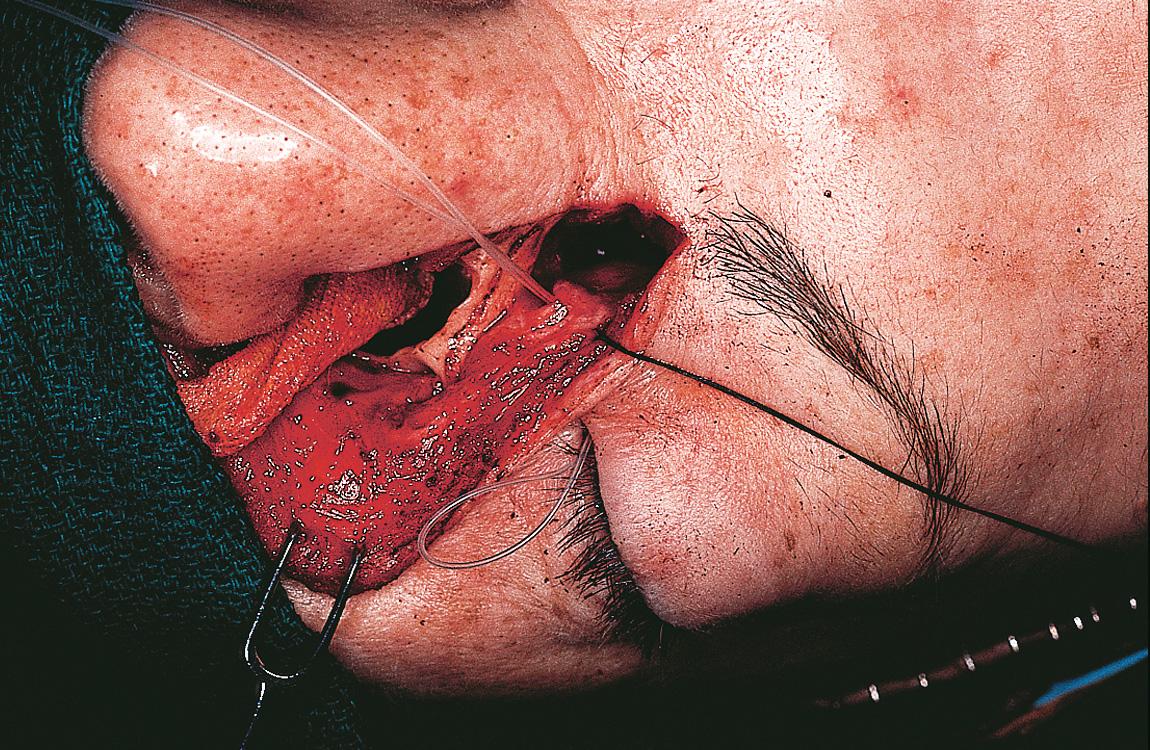
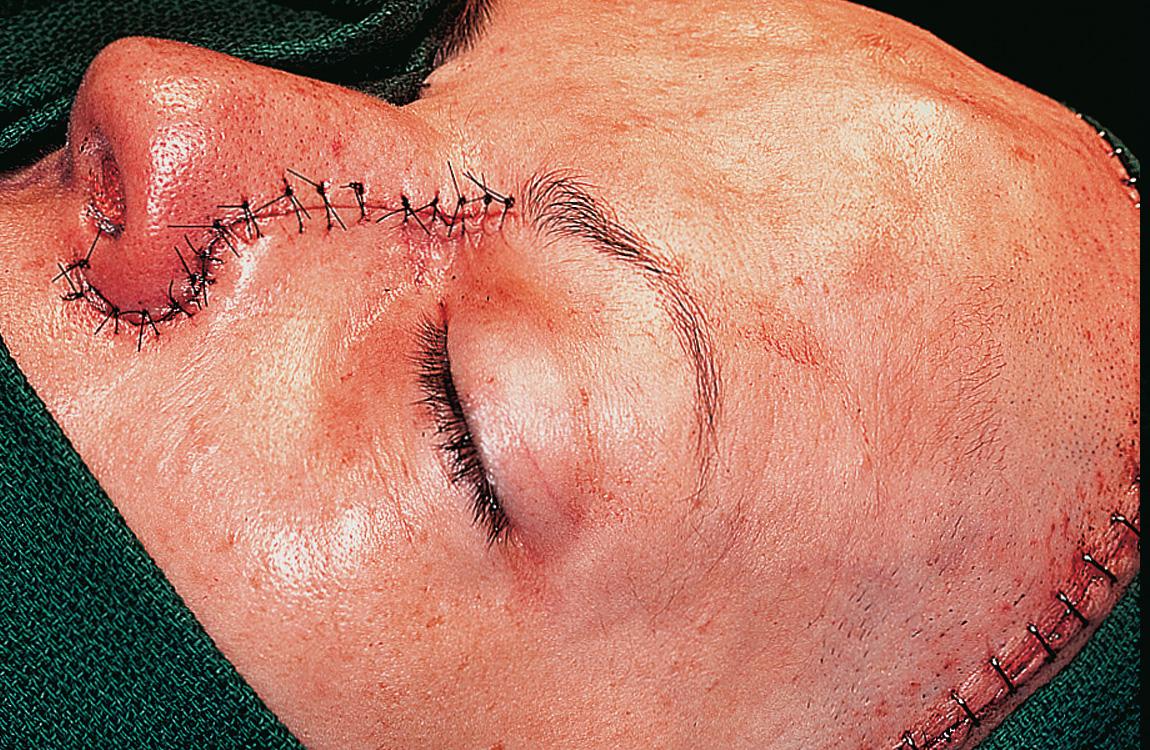
The appearance of the patient approximately 8 weeks after surgery shows well-healed incisions ( Fig. 6.74 ). The external facial deformity is minimal, the patient has binocular vision, and the position of the globe on the left-hand side is essentially normal.
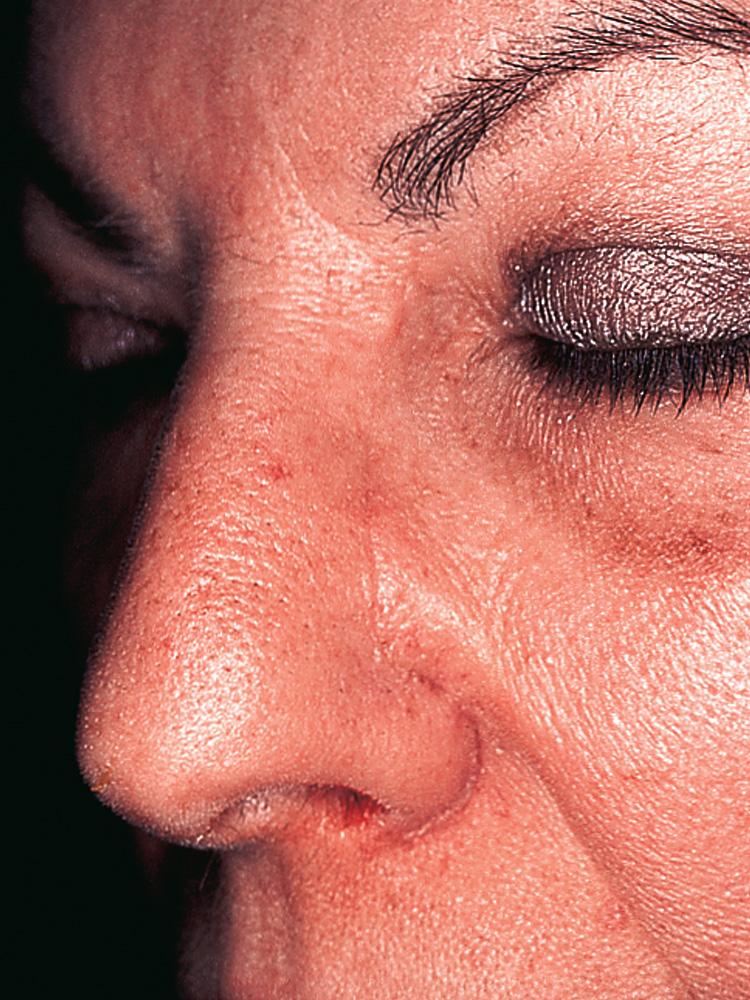
Postoperative MRI scans in axial and coronal views show total exenteration of the nasal cavity and the ethmoid complex up to and including the cribriform plate. The ethmoid tumor is thus completely resected ( Figs. 6.75 and 6.76 ).
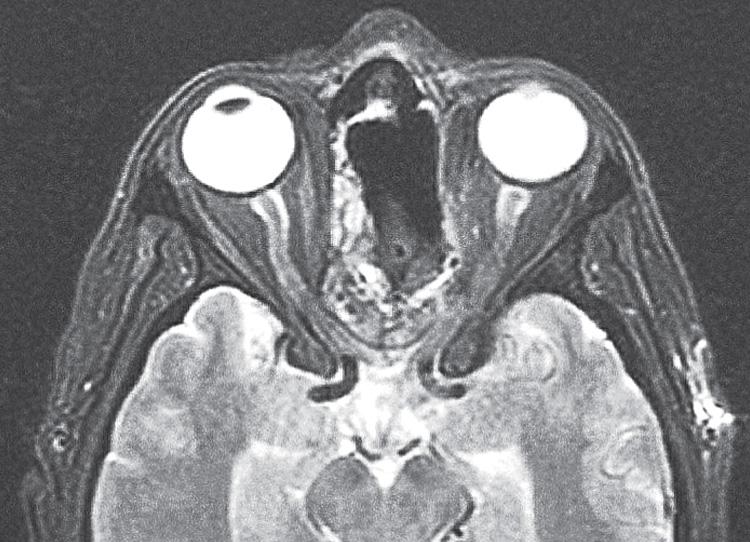
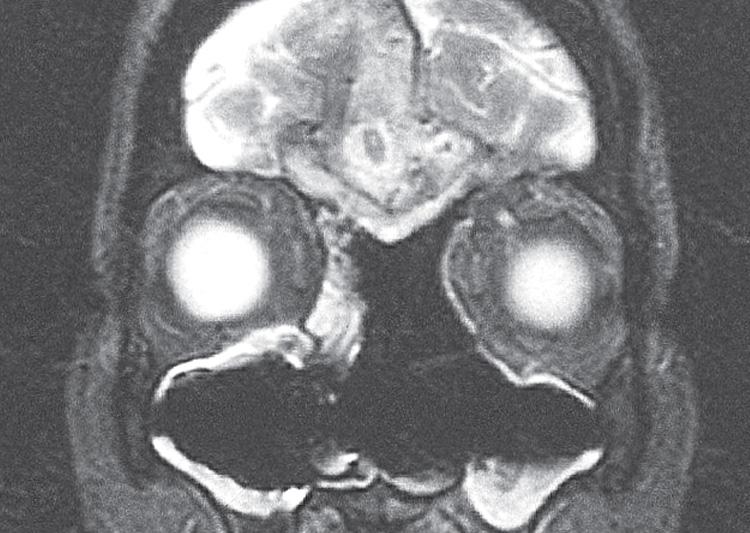
Several technical variations in the operative procedure can be used, depending on the individual situation and the preference of the surgeon. The evolution of craniofacial surgery during the past 50 years has led to the development of refinements in surgical techniques for better access, ease of resection, and reduction in morbidity and sequelae of the surgical procedure. These refinements largely have been able to be developed because of the availability of newer instruments and increasing cooperative efforts between multidisciplinary surgery teams to bring about an expeditious and successful execution of the operative procedure. In addition, long-term follow-up data for several patients who underwent operations during the course of the past 40 years are now available, which has provided the opportunity to observe the aesthetic and functional sequelae of craniofacial surgery. Several technical modifications now enable us to reduce the long-term sequelae of craniofacial surgery. These technical variations are described for each stage of the operative procedure.
The standard incisions required for anterior craniofacial resection requires a bifrontal coronal incision for craniotomy and a Weber-Ferguson incision. However, several variations in this standard approach can be used, depending on the individual situation. A unilateral supraorbital incision can be used for a limited frontal craniotomy when a primary tumor of one orbit involves the orbital roof, requiring limited resection. An upper lip–splitting modified Weber-Ferguson incision is the standard approach. However, for limited exposure, a lateral rhinotomy is often satisfactory. Alternatively, the facial incision can be avoided altogether, and nasoendoscopic assistance is often satisfactory for a complete resection.
Become a Clinical Tree membership for Full access and enjoy Unlimited articles
If you are a member. Log in here